Chinese Torture in East Turkestan
It has been shown in the preceding sections that the lands of East Turkestan have been Muslim for the last 1,000 years. Yet for more than half a century now, it has been living under occupation by the Chinese administration. A graffiti on a door at the University of Urumchi, described by Andrew Higgins (correspondent of The Independent) as "sheer racial venom" clearly reflects the Chinese view of the Uighur Turks:
Make Uyghur men our slaves forever and take Uyghur women as prostitutes for generations.25
China maintains up to 1 million soldiers under arms in the region, and controls everything that the Muslims in East Turkestan do. All vehicles are stopped at military checkpoints set up along the roads, the men are sometimes insulted and slapped about as their cars are searched, and Muslim women are abused. Chinese pressure is not restricted to stopping vehicles or frequent house searches by the military. The June 29, 2000 edition of the Japanese Mainichi Daily News described the oppression in the following terms:
 |
Chinese control [over East Turkestan] grows ever tighter and more intolerable. People's Liberation Army soldiers are everywhere. Travel and attendance at mosques are restricted. Communications are primitive and policed. Few farm villages have telephones, and urban phones are liable to be tapped. One can be jailed for years on mere suspicion of subversion.26
Muslims are arrested on invalid grounds and sent off to labor camps, executed on groundless charges, and from time to time martyred en masse. They are not allowed to fast, and are prevented from receiving religious instruction. The method used to stop the Muslim population from growing is utterly inhuman: Women are forced to have abortions, and the children of those who have more than one child are taken away from them.
In the face of all this cruelty and oppression, the people of East Turkestan have no means of protecting themselves or their rights. Muslims all over the world can help these defenseless people in many different ways. All measures to allow the voice of the people of East Turkestan to be heard and to attract the attention of international organizations are important.
The greatest assistance that can be given is to wage a struggle on the level of ideas to destroy the atheism that all that oppression stems from, and replace it with a just and proper morality. In that way, not just the Muslims of East Turkestan but all those who are martyred all over the world, or are forced from their homelands just for saying, "Allah is our Lord," or can be helped.
All believers share an equal responsibility in this matter. Allah reveals in a verse, "… Whoever strives does it entirely for himself…" (Surat al-‘Ankabut: 6). In another verse, He describes the responsibility that falls to believers in these terms: "Would that there had been more people with a vestige of good among the generations of those who came before you, who forbade corruption in the earth…" (Surah Hud: 116) Preventing evil in this world is the common duty of all people of conscience.
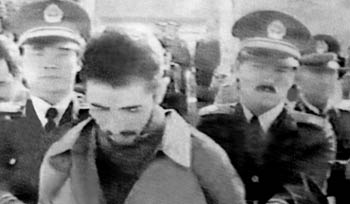 | 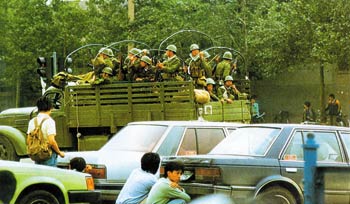 |
| The Chinese army controls East Turkestan with an iron hand. The Muslims' lives are rigidly controlled, and those whom the Communist Party regards as a threat are arrested. | |
The Structure of Communist Society
Communist ideology maintains that matter has no beginning or end, denies the existence of Allah, and rejects all spiritual values. It has been put into practice in a number of different countries, yet every time it has ended up inflicting terrible suffering. The reason for this is communist ideology's view of life and human beings. This is communist ideology's world view and the general structure of those societies in which it has been practiced:
 |
| The communist regime's ideal is an entirely homogenous society. The damage done by communist ideology, which attaches little worth to human beings and regards society as no more than a herd of animals, is even reflected in people's faces. |
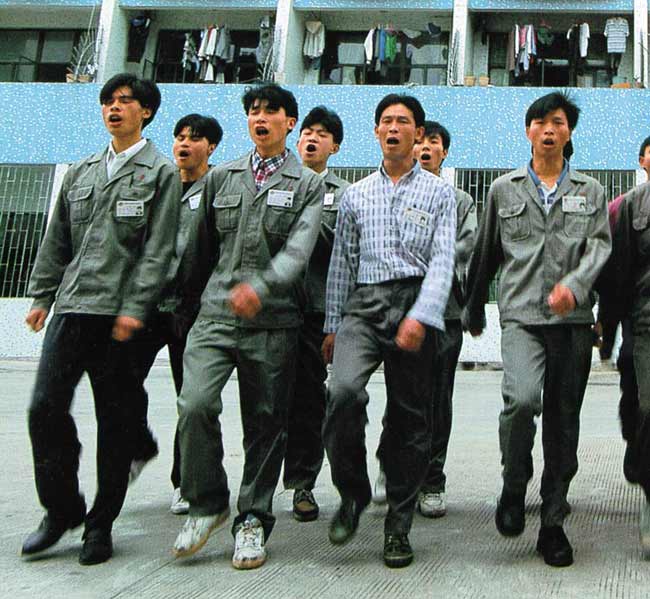 |
| Under communism people are only of value if they produce. They must therefore work like machines to benefit the system. According to this twisted view, those who are not productive are condemned to be eliminated. |
◉ The logic of "There are many members of the herd, so one fewer does not matter" prevails. The mentality which regards life as a "struggle for survival," sees nothing wrong with the elimination of the weak. On the contrary, it regards it as necessary. Selfishness is its defining feature. The crippled or those who cannot work are expelled from the herd and left to die.
◉ Just like animals in a herd, society is made up of one type of human being. People are made to dress, think and speak alike. There is little room for different cultures, beliefs or ideas.
◉ In communist societies, human beings are regarded as advanced forms of animal, based on Darwin's theory of evolution. For that reason, society is seen as a large herd of animals, and little value is ascribed to human beings.
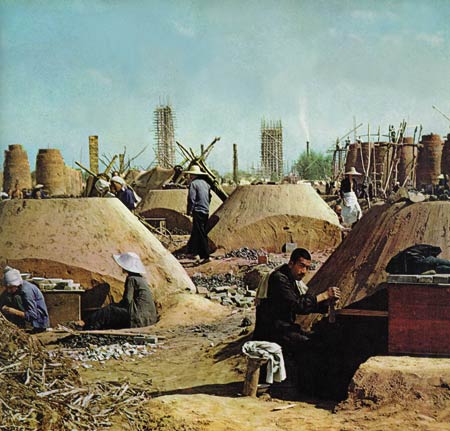 |
| In communist societies, good workers are the ideal human beings. People work in terrible conditions and under the command of oppressive leaders, and face severe punishment for the slightest infringement of the rules. |
◉ Individuals' contributions to society are more important than their own interests. Tireless workers and peasants are the ideal. The system is based solely on the material concepts of work and production. The logic of "production strengthens the herd" rules.
◉ No account is ever taken of human characteristics or proper morality. There is little room in communist societies for human feelings such as forgiveness, compassion, faith or love.
◉ Since fear of Allah is systematically destroyed, people are held back from committing crimes mostly because they fear the system itself. That is why an improper action can be committed if the system will not see it, or if the culprit will not be punished. Theft, prostitution, murder and moral degeneration are widespread in communist societies.
◉ According to communist ideology, which rejects belief in the hereafter, people cease to exist when they die. That explains why people do everything in their power to stay alive and remain strong. Since they believe they are engaged in a struggle for survival and see everyone else as a rival, they can easily perpetrate all kinds of evil in their own interests.
China's East Turkestan Policy Cannot Be Seen as Independent of Communist Ideology
China's policy on East Turkestan is a general reflection of communist ideology. That is why it is impossible to evaluate what is going on in East Turkestan independently of that ideology. Similar cruelty and oppression is inflicted on different individuals and communities all over China, which shows that a totalitarian structure is an inseparable part of communism. In this section we shall, therefore, be considering the cruelty and suffering inflicted by China's ideology and its despotic regime on its own people, as well as the suffering of the people of East Turkestan.
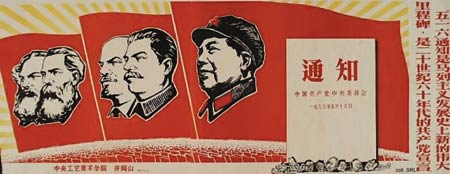 |
| Collections of the words of Mao were the people's only guides in communist China. In some posters, Mao compares himself to Marx, Engels, Lenin and Stalin. |
All regimes that are hostile to religion resort to pressure and violence in order to keep themselves in power. The most oppressive, dictatorial regimes have always oppressed, even despised, the people who resisted their policies. From this point of view there is little difference between Pharaoh and Hitler, Hitler and Stalin, or Stalin and Mao. None of these leaders had any hesitation about killing innocent people and ordering terrible slaughter for the sake of power and their own ideologies. Just like the others, Mao set up concentration camps in order to strengthen the communist regime, turned them into torture centers, and had millions of people who failed to think like him ruthlessly killed.
The People's Republic of China, founded in 1949, was built upon totalitarian despotism, intense bureaucracy, and a system of state control of all resources and means of production. The disasters brought about by Mao's economic policies and his policies of restricted famine led to enormous loss of life and a general collapse. Mao's successor, Deng Xiaoping, hoped to put the economy right by carrying out economic reforms and opened the country up to foreign investors and a liberal economy. Yet those economic improvements only benefited the top levels of the state machinery. The people of China benefited very little. Moreover, despite the trend towards a liberal economy there was very little equivalent political or social progress. No matter how much people talk about "the old communist system" with regard to China, and claim that communism has come to an end, the facts disprove this claim.
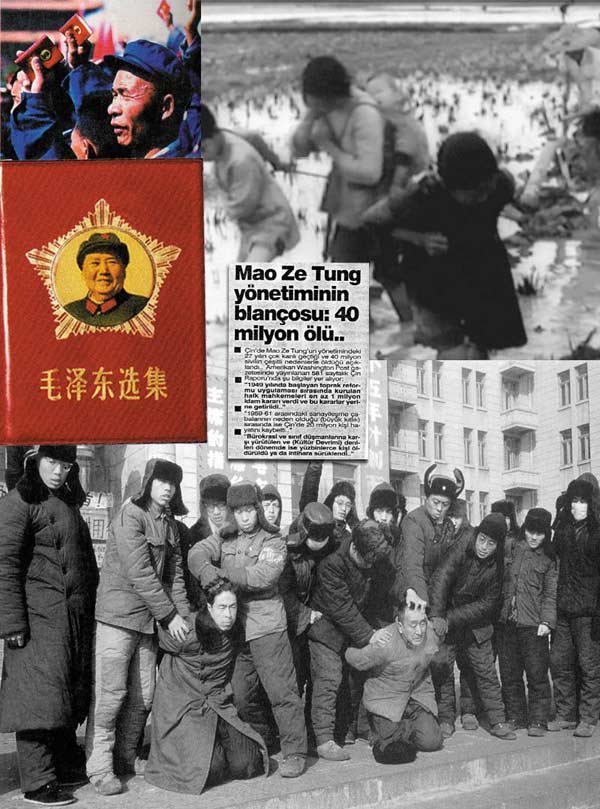 |
| The teachings of Mao, based on ruthlessness and brutality, led to the death of millions. |
| "THE DEATH TOLL OF MAO ZE TUNG'S ADMINISTRATION: 40 MILLION DEAD."- Günaydin 21.07.94 |
China is still run by a totalitarian mentality that has its roots in Mao's vision of communism. The reforms in the economic field have not brought about any major changes in the minds of the leadership of the Chinese Communist Party.
 |
| Nothing in the Chinese government's policy of oppression changed during the time of Deng Xiaoping (side), who came to power after Mao. |
A large part of the economic progress and revenues are used to increase the repression of the population and to silence the voices of opposition. China currently has the highest capital punishment rate of any country in the world. Furthermore, it is perhaps the only country in which executions are turned into public spectacles, and where the internal organs of those executed are removed without their permission and sold for profit, where pregnant women are forced to have abortions. There are more than 1,000 labor camps in the country, and those detained in them are systematically tortured.
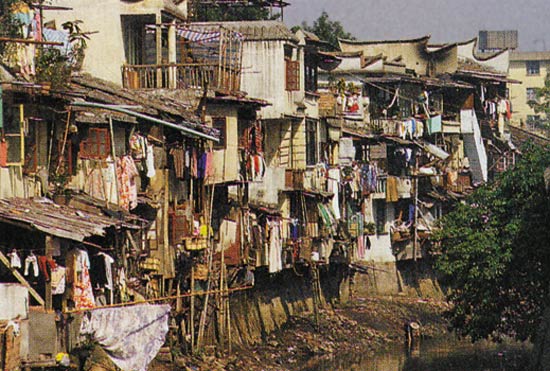 |
 |
| Only Communist Party officials benefit from the economic liberalization in China, and the people as a whole continue to live in hunger and poverty. |
Executions in China Are Just a Routine Matter
The death penalty is an important control mechanism of the Red Chinese regime. The famous Chinese dissident Harry Wu describes the situation in his country as follows:
The dictatorship is tightly associated with violence and has even grown dependent on it. It practices the Chinese idiom of "Kill the Chicken to Scare the Monkey." The public education carried out by sentencing rallies and mass executions shows the Party's reliance on public violence.27
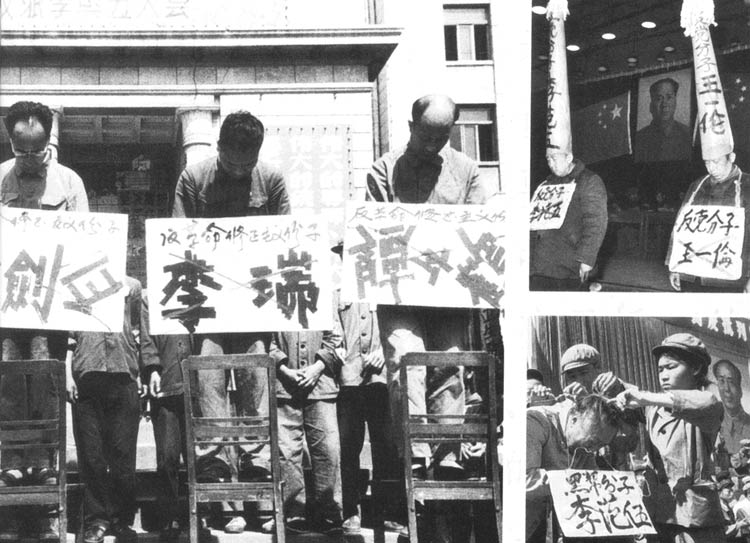 |
| Party leaders accused of supporting capitalism are first put on public display, and then are executed. |
Although it is impossible to specify the exact number, millions of people have executed by the Red Chinese regime. Most figures are based on estimates, although the latest research has revealed that the number of people killed is much higher than was previously believed. The fact that the communist regime regards executions and murder as one of its basic principles is well known. In a confidential document dated May 16, 1951, Mao revealed that the number of people to be killed had been established in line with a definite quota:
Talking about the number of counter-revolutionaries to be killed, a certain proportion must be set. In rural areas, it should not exceed 1/1000 of the population. In killing counter-revolutionaries in the urban areas, generally it should be below 1/1,000 of the population; the number .5/1000 seems appropriate. For example, among the 2,000,000 people of Peking, over 600 were killed. Another 300 are planned to be killed. A total number of 1,000 will be enough… It is still necessary to kill other big batches and we must do all we can do to kill two thirds of those who are predetermined to be killed by the end of July. 28
When planning his massacres, Mao saw no need to prove that the person to be killed actually committed a crime. He regarded killing as necessary simply because of the fear it would instill in society, and saw that number of executions as a "matter of quotas." Another example of this way of thinking is found in Stalin's famous statement: "the death of one person is a tragedy, a million deaths is a statistic."29 As a result of the communist Stalin's "statistical" murders, an estimated 40 million innocent people lost their lives.
Mao had no hesitation about personally signing the death warrants of those to be killed. In a document dated January 17, 1951, he gave the following order to his comrades, which included Deng Xiaoping:
In 21 counties in western Hunan, over 4,600 bandit chieftains, local tyrants, and Kuomingtang agents were killed. Another batch are planned to be killed this year by local authorities. I believe this disposal is very necessary… in places, we must kill big batches…dealing heavy blows means killing all reactionaries that should be killed with a firm hand.30
In the early days when Mao was still alive, executions were carried out with great speed, sometimes in public and at other times in secret. In 1953, for instance, a woman called Yang Pei only learned that her husband had been executed when she applied for a divorce.
Executions continued in the Deng period. At the same time, an unbelievable "savings" measure was started, under which the cost of the bullet fired into the skull of the person executed was paid by his family. The state also found another means of turning a profit out of executions: The internal organs of the executed were sold, and all the profits went into the state coffers.
It is clear, therefore, that the current rulers of Red China are merely following in the footsteps of their so-called "eternal" leader Mao when they stage public executions or murder people in labor camps.
Executions are still staged on a regular basis in China. It is not known how many people are executed in the course of a year because the Chinese government treats such information as a state secret. However, the following figures will help to provide a general idea:
Amnesty International has reported there were 2,050 executions in China during 1994. It recently released the figure of 1,313 reported executions in China during the first half of 1995.31
The numbers have risen still further in the 2000s. In the first three months of 2001, 1,781 people were executed. That figure does not include the 2,960 people still awaiting execution.32
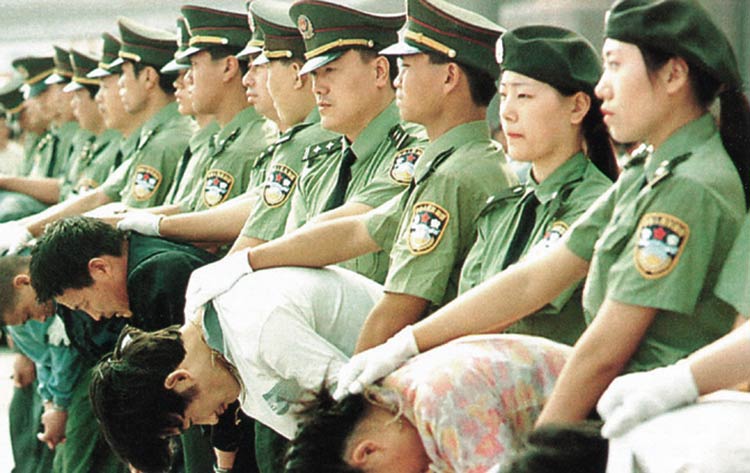 |
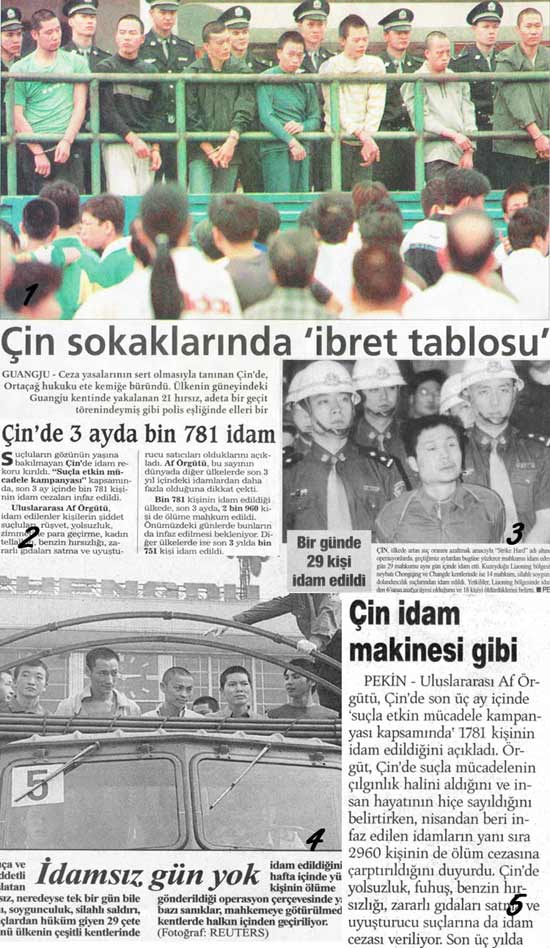 |
| 1) "THE "PICTURE OF DETERRENCE" IN CHINA'S STREETS". Radikal 19.06.01 |
| Only a very few of the executions in China are reported in the press, yet even these are enough to show the scale of the brutality. |
 |
| In an article in The New York Times called "Chinese Justice Tools: Torture and Executions," it was reported that China has the highest number of executions of any country in the world. Some people sentenced to execution are first paraded in the streets, and then killed in full public view. The cost of the bullets used in executions is reclaimed from the families of those executed. |
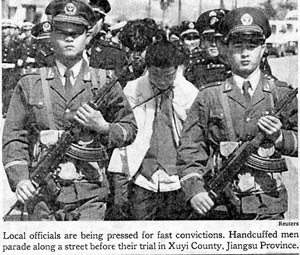 |
| New York Times 9.9.01 |
That figure is more than all the other countries in the rest of the world combined for the last three years alone. Among those executed are people from all kinds of social groups, including girls aged 15-16 and religious leaders. The common "crime" of the great majority of these people was to want to live in freedom in their own country and to enjoy the most basic human freedoms, those of speech, thought and worship. Yet in the eyes of the Chinese government, both common criminals and supporters of democracy are all "counter-revolutionaries." That is why as many people are executed for "thought crimes" as for ordinary criminal offences. What is more, a number of new methods have recently been introduced in order for those guilty of "political crimes" to be executed. The most widespread of these is political detainees are accused of trumped up criminal offences.
Chinese officials have always thought that capital punishment was necessary in order to keep the public in line and to strengthen the government. For that reason, they choose to parade those to be executed through the streets and then kill them in full public view. Those to be killed are brought before the public in handcuffs and made to face the spectators. Their names and crimes are written on placards hung around their necks. These scenes of savagery in full public view are also broadcast live on television.
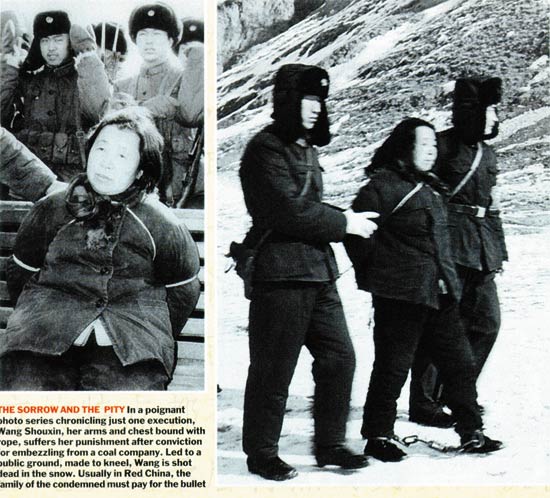 |
| Wang Shouxin, accused of corruption in a coal business, was just one of thousands of Chinese people killed in the snow with a single bullet. Red China extracts the cost of the bullet employed from the families of the executed. Such brutal scenes are often to be witnessed in China. |
Those who disbelieve and
bar access to the Way of Allah have gone very far astray. Allah will not forgive those who disbelieve and do wrong or guide them on any path.
(Surat an-Nisa’: 167-168)
 |
| In the article "Torture Hurries a New Wave of Executions in China," in the September 9, 2001, edition of The New York Times, it was stated that some 191 executions are carried out daily as the result of statements given under torture. According to the report, at least 3,000 people had been executed since April, and a further two or three times that figure were expected to be executed. |
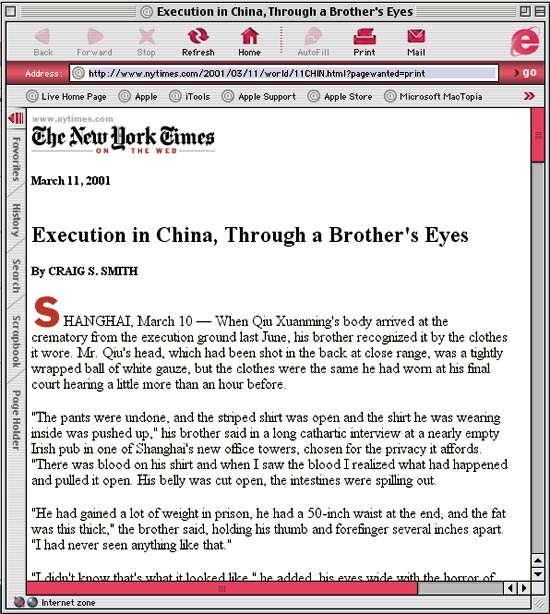 |
| The article "Execution in China, Through a Brother's Eyes" in the March 11, 2001, edition of The New York Times told the story of Qui Xuanming, who was shot in the back of the head in front of his brother because he was unable to pay his tax debt. |
Following the publication of scenes of mass executions in Newsweek magazine in 1984, the Chinese government feared that this might damage the country's image, and issued an order that those condemned to die should no longer be paraded through the streets. That order was subsequently expanded, and the fact that political detainees had been executed was to be kept secret even from their families. These instructions did not mean that political killings had been done away with in China, but that they were still proceeding apace, albeit out of sight. Following the events in Tiananmen Square in 1989, concerns over domestic policy overrode the country's image abroad, and many involved in the opposition were publicly executed.
 |
| Mass executions and the parading of those due to be killed through the streets M have been methods employed since the earliest days of communist China. |
Red China's habit of executing people due to their ideas was also seen during the time of the Prophet Moses (pbuh) and one of the cruelest despots in history – the Egyptian Pharaoh. Pharaoh threatened the followers of the Prophet Moses (pbuh) with death because they refused to obey him and to abide by his rules. That threat is reported in the Qur'an:
He [Pharaoh] said, "Have you believed in him before I authorized you? He is your chief who taught you magic. But you will soon know! I will cut off your alternate hands and feet and I will crucify every one of you." (Surat ash-Shu‘ara’: 49)
Familiar Images of Executions in Red China |
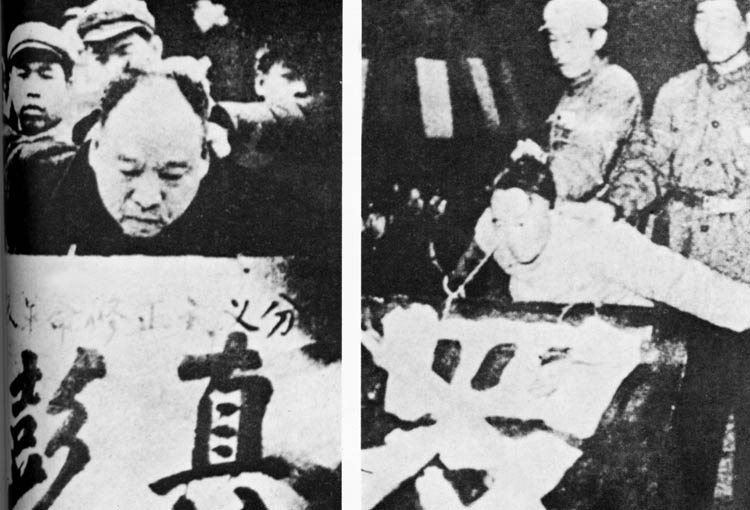 |
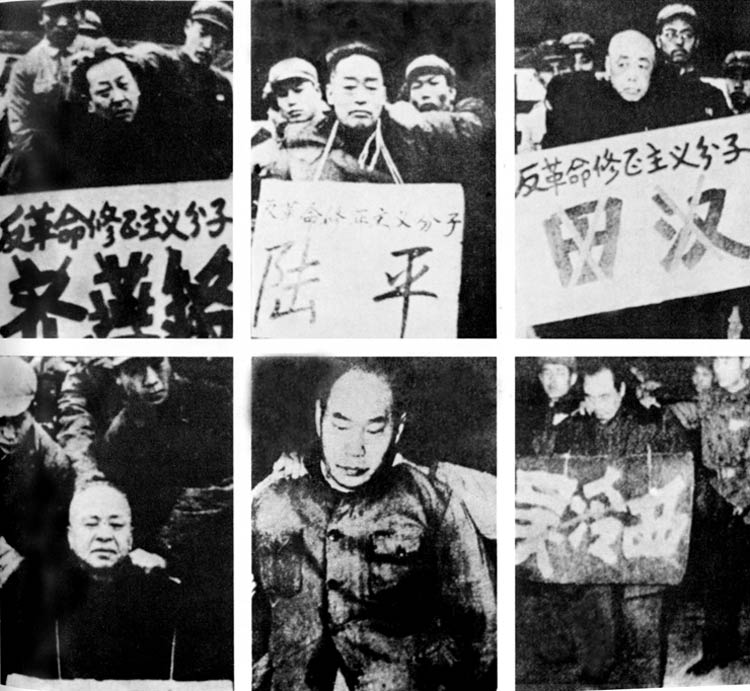 |
Executions Are Still Being Carried Out in East Turkestan
Although China's policy regarding its own people is utterly ruthless, things are even worse in East Turkestan. The number of East Turkestan Muslims executed is enormous. Any initiative by the Muslim population to live according to their religion or speak their own language, which are fundamental rights, is savagely punished.
Just as in China as a whole, executions still go on in East Turkestan, and innocent people are martyred in the absence of any firm evidence. Chinese courts are not independent like those in democratic countries, but operate within the framework of the Communist Party's political agenda. That is why the cases of people condemned to death are heard very quickly, and defendants are not given the necessary time and means to defend themselves properly. The death penalty is usually carried out so fast that families concerned are unaware of its event. According to official figures, 210 Muslims were martyred in East Turkestan alone in 1997-1999, and it is believed that the true figure is actually a great deal higher.33 Executions are carried out every single month, and Mao's method of "killing by quotas" is scrupulously implemented.
Muslims executed in East Turkestan. |
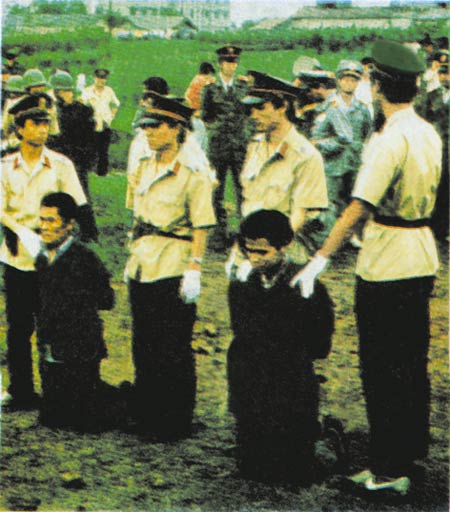 |
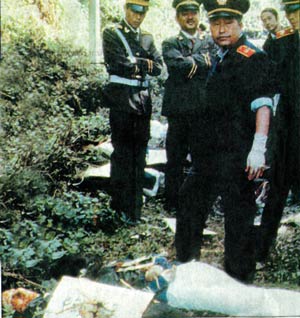 |
 |
| When the young people of East Turkestan express the entirely justified demand to be allowed to live by their own religion and culture, they are punished with death by the communist regime. At the outset, some executions were broadcast by Chinese television as a "deterrent." However, the Chinese government later abandoned that practice out of concern over protests. |
One of the methods resorted to by the Chinese regime in order to intimidate the Muslim population is mass arrests and torture while in detention. Most Muslims under arrest are sentenced to long terms in labor camps, and many of these are never heard of again. Families have no idea where prisoners are being held, or whether they are alive or dead.
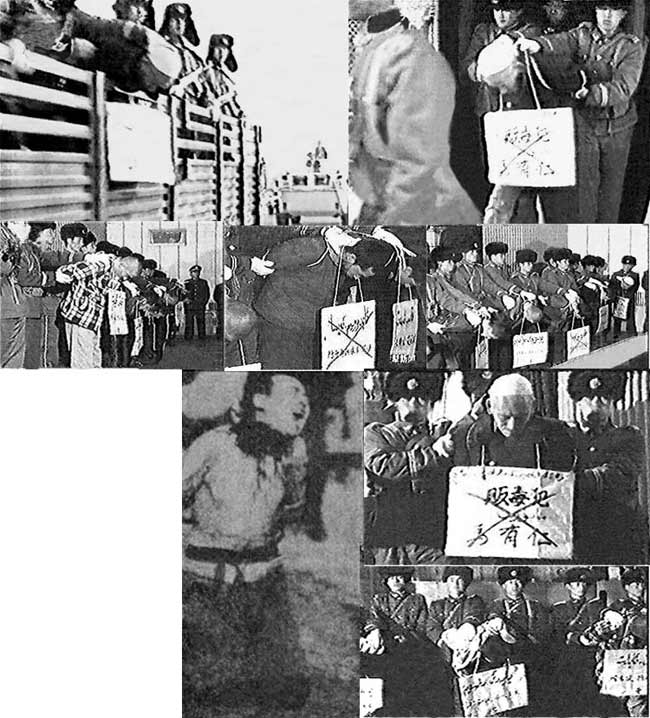 |
| The Soviet Colonel Yusuf Samilov who fled from communist China and joined the Turks, was killed by Chinese troops by having nitric acid poured over his neck. |
Pharaoh said, "Have you believed in him before I authorized you to do so? This is just some plot you have concocted in the city to drive its people from it. I will cut off your alternate hands and feet and then I will crucify every one of you."
(Surat al-A ‘raf: 123-124)
 |
| 1) "The Execution On 4 East Turkestan Muslims" Akit 17.03.01 |
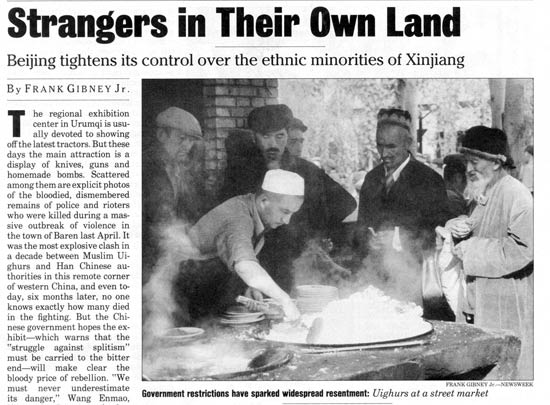 |
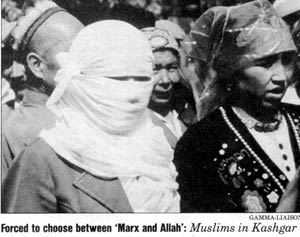 |
| Newsweek 1.1.90 |
Torture is widespread in Chinese prisons and labor camps. Various international organizations have drawn attention to the systematic torture carried out in China, and in their reports have warned the Chinese government. One of these was a 34-page report published by Amnesty International in 1999, which considered human rights violations in East Turkestan. One of the many incidents described in the report concerned descriptions of the grim prison conditions by the relatives of one 17-year-old detainee:
The jail was so crowded that prisoners were held 5 or 6 to a single cell – too small to allow them all to lie down at night; they had to take turns to sleep. Whenever police officers "visited" them in their cells, they were beaten. Those prisoners selected for interrogation were taken to a special room where they were beaten, kicked and given electric shocks with electric batons. The interrogation room was equipped with a rail fixed on the wall. Some prisoners were hung on the rail with one foot and one hand tied to the rail with handcuffs. They were left in that position for 24 hours. When they were untied, they could not stand straight. Some prisoners had their fingernails pulled out with pliers. Others had wires inserted under the nails.34
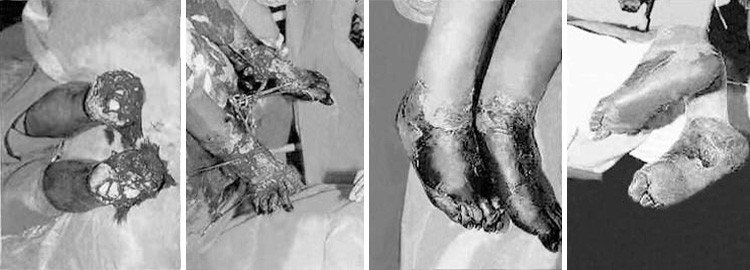 |
| Just one of the thousands of Uighur Turks, arrested by the Chinese security forces in Gulja on February 4, 1997, subjected to unbelievable torture simply because of their beliefs. |
The prisoner who underwent those experiences spent two months in prison, and was only released following payment of a 2,000 yen bribe by his family. The torture inflicted on another prisoner at the Public Security Bureau after being arrested was even more pitiless. What is more, that person's only crime was to meet and engage in an exchange of ideas with friends:
 |
| Some Chinese torture methods |
Next to the detention centre is an underground place where some suspects are interrogated. He was questioned there in the evenings and tortured in various ways. For example, his hands were tied behind his back and the interrogators would lift his arms, pulling them up high in a twisted and painful position behind his back. He was given electric shocks with electric batons. The shocks were applied all over his body, including in his mouth and on his penis, which caused intense pain. The interrogators hit him on the bones of the legs with a wooden baton. They made him kneel down and hit him on the thighs and the shoulders with the baton. While tortured, he was made to wear a kind of metal helmet which came down over his eyes. The interrogators used this helmet to prevent fatalities, as some prisoners cannot bear the pain of torture and try to kill themselves by bashing their heads against the walls.35
Conditions in the so-called "re-education through labor" camps that convicted prisoners are sent to are even worse. "Re-education" in China means making someone accept communist ideology and be willing to obey the orders of the Communist Party, at no matter what price. The methods employed to that end are totally inhuman:
Prisoners in the camp work on average 10 hours a day at making and carrying bricks, cutting and transporting stones, and agricultural work. They are punished severely if they do not go to bed or get up on time, if they talk to each other, if they sing songs or shout, laugh or cry, if they secretly take water to wash themselves for prayer, if they do not finish their allotted tasks, or if they answer back to the police or guards. The punishments include being hit on the head, stomach and crutch with electric batons; being made to lie down and having their hand trodden on; being made to stand in the "flying aeroplane" position; being strapped to a pole and beaten, and being hung from the ceiling and beaten. On several occasions, police officers inserted an electric baton into a prisoner's anus. Many prisoners have lost their teeth, have bleeding ears, broken arms, infected and useless testicles due to torture. They are frequently insulted and humiliated by the guards. At mealtime, they have to sing songs of praise in Chinese, failing which they reportedly go without food. The camp has no doctor. Prisoners who are sick have to work or are given no food, and only those who are incontinent are taken to the hospital 36 kilometers away. Some have died on the way to hospital.36 China's policy in East Turkestan is a program of mass torture and genocide. According to information from the East Turkestan Information Center, some 10,000 Uighur Turks were arrested on trumped up charges between the beginning of 1999 and March of that same year, detained under the sort of conditions we have seen above, and sentenced to stiff punishment, especially the death penalty, by courts operating under the control of the Communist Party. The number of people sentenced to death by courts in East Turkestan or who died as the result of torture between the beginning of 1999 and March, 2000, is estimated to be 2,500.37
In the genocide campaign being waged by the Chinese government in East Turkestan, even children are detained on various charges. For instance, on October, 30, 1999, the Hotan Municipal Security Directorate arrested a Turkish girl, a middle school student, on the grounds that her writing resembled that of a poster that had been put up in the street. During a speech made by Regional General Secretary Wang Le Chuan in Hotan, which was closed to the press, he announced that a primary school student had been arrested because he had torn the picture of Chairman Mao on the cover of his school book.38
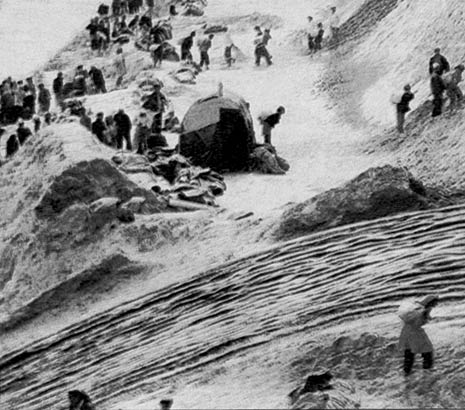 |
| In present-day China there are more than 1,000 labor camps. Huge numbers of people, including Muslims, are forced to work in the most terrible conditions. The income from these camps forms an important part of the Chinese economy. |
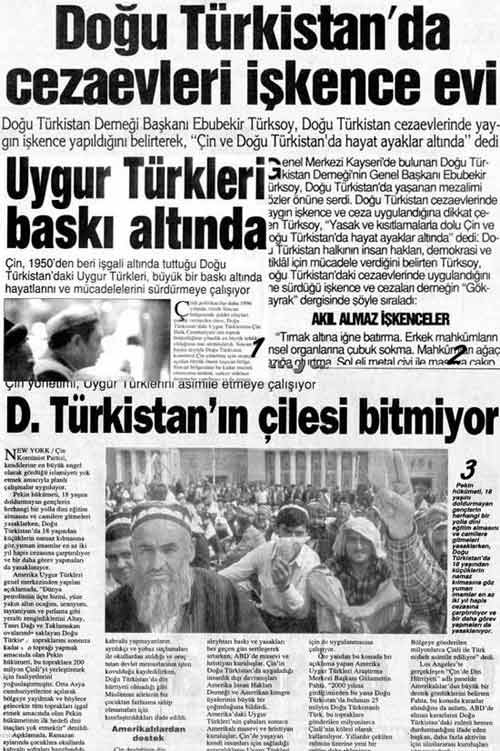 |
| 1) "The Uighur Turks Are Oppressed" Yeni Mesaj 30.09.01 |
| The oppression of Uighur Turks by China is reported frequently in the Turkish media. |
 |
| 1) "China is Spreading Terror Throughout East Turkestan" Milli Gazete 28.09.01 |
 | |
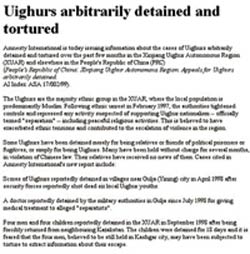 | Foreign publications such as Amnesty International Briefing and Crescent International describe in great detail the oppression and cruelty faced by Muslims in occupied East Turkestan. (Crescent International, 1.11.01) |
 | |
 |
| Hundreds of Muslims are martyred in organized executions. Thousands more are still in prison, awaiting execution. |
Examples of Mao - Style Torture |
| The name of Mao Tse Tung is remembered today for cruelty and brutality. He had unimaginable tortures inflicted on, not just the people of East Turkestan, but on his own people as well. The actions of the Red Guards under Mao's instructions during the barbaric period known as the Cultural Revolution in particular, were crimes against humanity. The following are just a few of them: To put those special handcuffs tightly on the wrists of a prisoner was a form of torture commonly used in Maoist China's prison system. Sometimes additional chains were put around the ankles of the prisoners. At other times a prisoner might be manacled and then have his handcuffs tied to a bar on the window so that he could not move away from the window to eat, drink, or go to the toilet. The purpose was to degrade a man in order to destroy his morale… Since the People's Government claimed to have abolished all forms of torture, the officials simply called such methods "punishment"' or "persuasion." 1 The whole people were invited to public trials of "counterrevolutionaries," who almost invariably were condemned to death… Everyone participated in the executions, shouting out "kill, kill" to the Red Guards whose task it was to cut victims into pieces. Sometimes the pieces were cooked and eaten, or force-fed to members of the victim's family who were still alive and looking on. 2 In The Black Book of Communism an observer described the inhuman treatment meted out to university professors detained during the days of Mao: Hanging from their necks were pails filled with rocks. I saw the principal: the pail around his neck was so heavy that the wire had cut deep into his neck and he was staggering. All were barefoot, hitting broken gongs or pots as they walked around the field crying out: "I am black gangster so-and-so." Finally, they all knelt down, burned incense, and begged Mao Zedong to "pardon their crimes."… A few girls nearly fainted. Beatings and torture followed. I had never seen such tortures before: eating nightsoil and insects, being subjected to electric shocks, being forced to kneel on broken glass, being hanged "like an airplane" by the arms and legs. 3 The same book also mentions the prisons: The most varied and sadistic tortures were quite common, such as hanging by the wrists or thumbs…. The most brutish people were allowed to operate with impunity. One camp commander assassinated or buried alive 1,320 people in one year, in addition to carrying out numerous rapes. |
| 1. Nien Cheng, Life and Death in Shanghai, Macdonald, London, 1986, pp.224-226, cited in The Black Book of Communism, Harvard University Press, Cambridge, 1999, p.509. (emphasis added) 2. Ibid., p.470-471. (emphasis added) 3. Ken Ling, Miriam London and Lee Tai- Ling, Red Guard: From Schoolboy to "Little General" in Mao's China, Macdonald, London, 1972, pp. 18-21. cited in The Black Book of Communism, p. 525. (emphasis added) 4. Ibid, p.482. (emphasis added) |
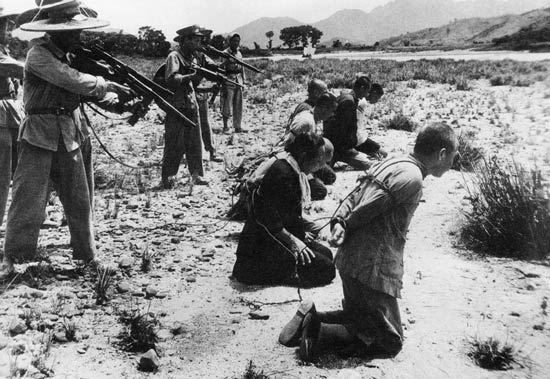 |
| The Red Guards ruthlessly killed anyone they regarded as an enemy of the regime. The picture shows prisoners killed by the riverbank after the capture of Beijing. |
 |
| Farmers whose lands were taken away were tried by Mao's militants in "People's Courts" and then ruthlessly killed. |
The Laogai "Re-Education Centers"
The laogai in China are the equivalent of Hitler's concentration camps and Stalin's gulags. The laogai system is intended to totally dominate people's thoughts, and turn them into slaves. It is one of the Chinese state's most important control mechanisms. So far some 20 million people have lost their lives in these camps.39 The aim behind these camps is "re-education" by means of forced labor. One of the most frequently employed slogans is "Forced labor is a means, and a revolution in thought the end." To put it more clearly, the intention behind the laogai is to use all possible means to oblige those who are seen as a potential threat to conform to the Communist Party's wishes. That in turn means humiliation, oppression, enslavement and torture.
These camps are often concealed by using other names for them, and may look like factories, mines or farms to fit the name. An article in The Washington Post described one of these camps, "Hunan Special Electric Machine Factory," or "Hunan Province No. 1 Prison," in which 2-3,000 prisoners are forced to work for an average of 16 hours a day. The factory used to make industrial generators, but now produces various goods such as wigs, medicine boxes, gloves, and Christmas lights.40
Laogai camps are actually intended to punish prisoners, and inmates are exploited by being forced to work under very harsh conditions. The inmates of laogai camps have no rights. They are made to work in state factories, mines, and farms, and to abide by the rules. An individual is kept in these camps until the authorities decide he has been completely reformed (in other words, torture and cruelty are applied until he is molded and obedient to the Communist Party's wishes.) That can sometimes take a whole lifetime, as even if a prisoner has served his entire sentence, he is still kept in the camp to carry out other tasks until the administration decides he has reformed. It is known that, as of 1997, there were more than 1,000 laogai camps in China as a whole, with 8-10 million inmates.41
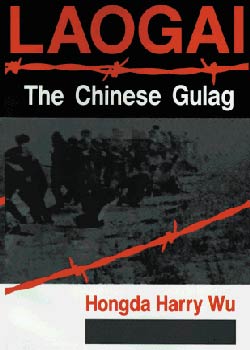 | 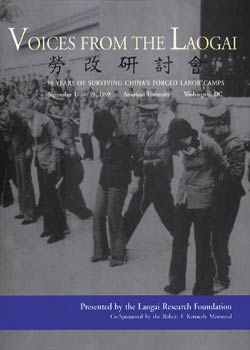 |
| Millions of people have died in the Chinese concentration camps known as laogai. Even the few books that have described what goes on in these camps are sufficient to reveal the ruthlessness of the communist regime. | |
The income from what the prisoners produce forms an important part of the Chinese budget. One study in 1999 revealed that 99 laogai camps recorded annual sales figures of 842.7 million dollars.42In other words, a great many of those people all over the world who use goods made in China are actually using products made by forced labor in Red Chinese state camps. For example, China is one of the world's major tea producers and one-third of the tea it exports comes from laogai camps. The worker slaves in those camps produce 120 different varieties of tea, and are punished if their products are not up to a sufficiently high standard.43
 |
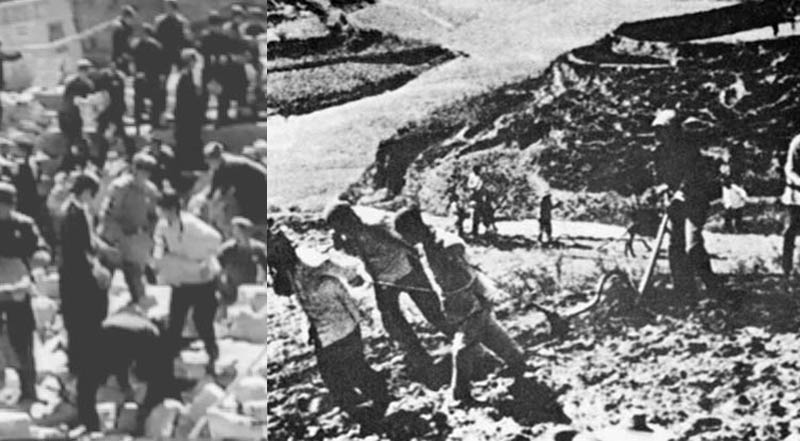 |
| Hitler's concentration camps and Stalin's gulags were replaced in China by the laogai. Most of the people in them were supporters of democracy and human rights, and were accused of opposing the regime. The aim was to mould these people into the shape the communist regime wanted. To that end, prisoners are forced to work 10-16 hours a day in the most terrible conditions, and were humiliated and tortured. |
In fact, one of communist ideology's fundamental principles, the idea that "people are only important so long as they are productive, and the important thing is to increase production," also applies in the laogai. In the view of the Chinese Communist Party, human beings are the most important means of production, and everyone must serve as vehicles of that production. Violence is, in turn, the most effective way of raising production. Harry Wu, who spent 19 years in the laogai, now claims asylum in the United States. He has since used the Laogai Association he founded as a means of fighting the human rights violations in China. Wu calculates that the laogai make a profit of some 100 million dollars a year, a figure that has been accepted in official statements from Beijing.44
 |
As we have seen, the laogai are not simply a prison system, but rather an important political tool for the survival of the Communist Party. Mao expressed this in these words:
Marxism holds that the state is a machine of violence for one class to rule another. Laogai facilities are one of the violence components of the state machine. They are tools representing the interests of the proletariat and the people's masses and exercising dictatorship over a minority of hostile elements originating from the exploiter classes.45
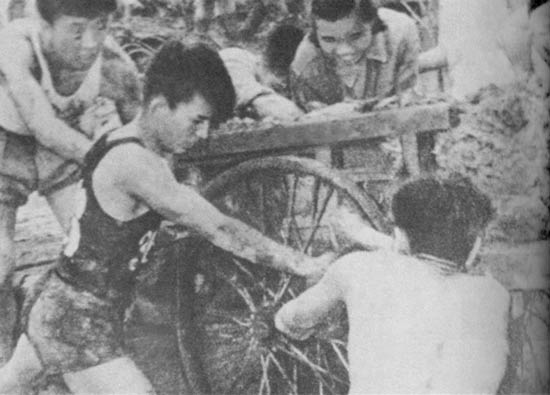 | 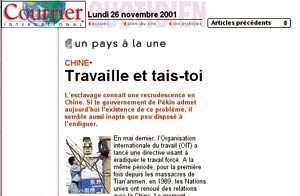 |
| Anews report headed 'Work and be silent' in the French magazine Le Courrier International revealed the full details of the repressive nature of the camps. The report spoke of minors under age 18 being forced to work without pay and locked in cells like stables at night. The article described how the Guangdong camps in particular were no better than the concentration camps of World War II, and concluded: "It is a truly terrible situation. These people are in an awful position in which it is difficult even to survive…" | |
No matter how much the Chinese government attempts to conceal the true nature of these camps, those people who have spent many years in them, and then found asylum abroad, keep telling the world about what goes on in the laogai. One of these is Jean Pasqualini who spent many years in a laogai. He claims that the laogai is not an institution, as has been claimed, but rather a system of torture. He describes how the most inhuman things possible go on in these camps. Pasqualini claims deceptive language is employed by Red China when discussing the laogai or the punishment of prisoners. In his view:
Prisoners in China are still compelled to work, to "reconstruct socialism with their two hands," in order to "reform themselves," to be "born once again," to become "new men." Slave laborers in "Laogai" brigades not only work hard under inhumane conditions merely to purge their crimes but also to "expiate for their sins." The Chinese penal system has a very peculiar vocabulary: nearly every inhumane terminology has a human correlation. One is never "punished," one "undergoes reform." Prisons are often called "schools" where one serves time by "studying and learning" and "reforming oneself." A prisoner never gets beaten, he is "given a lesson." He never gets insulted, he just gets "criticized." And the jail authorities lose no time to let you know that "criticism is proof that the government is concerned about you. Without criticism there can be no progress!" Informers are those who help the government (that is, the warders) to do its work well. They also "help" prisoners to "recognize their mistakes." The word "help" is considered the most frightful term in the prison vocabulary by the prisoners! Prisoners don't spy on each other, they just engage in "mutual supervision." Prisoners who have served out their time are said to have graduated or "have gone back to society," "to have obtained a new lease on life" or to have "once again joined the ranks of the people".46
This deceptive terminology employed by the Chinese communists was described in George Orwell's 1984, and recalls the Ministry of Love, whose true purpose was to inflict suffering. This false terminology employed by communist totalitarianism can be seen in all areas of life. Jean Pasqualini discusses that peculiar terminology:
The dictatorship of the proletariat has now given way to the "People's Democratic Dictatorship." As if a dictatorship can be democratic. Or democracy can tolerate a dictatorship. One has to be one or the other. Not both! The terminology has changed, but its purpose remains the same. The terrible famine of early '60s that claimed 20 million lives was for a long time officially known as the "three years of temporary economic difficulties (or hardship)." Not a single word about the victims of the consequences of the Great Leap Forward which continued to be extolled during the catastrophic period. On the contrary, the situation then was described as being "good and great."47
China Sells Prisoners' Internal Organs
Under the pretext of medical aid, benefiting the sick, and research, for years the Red Chinese administration has sold the internal organs of people condemned to death in order to provide itself with income. In fact, these people’s organs are sold for high profit. After people have been executed, the state makes an average 10-15,000 dollars profit out of each usable organ. Under the law "On the Use of Executed Prisoners' Corpses or Organs" issues in the '70s, the use of such organs was legalized. If a prisoner has no family, or if he or they have given permission for his organs to be used after death, those organs are removed and sold after sentence has been carried out.
That might seem quite acceptable, but one can see how unjust this policy actually is when the prevailing conditions in China are considered.
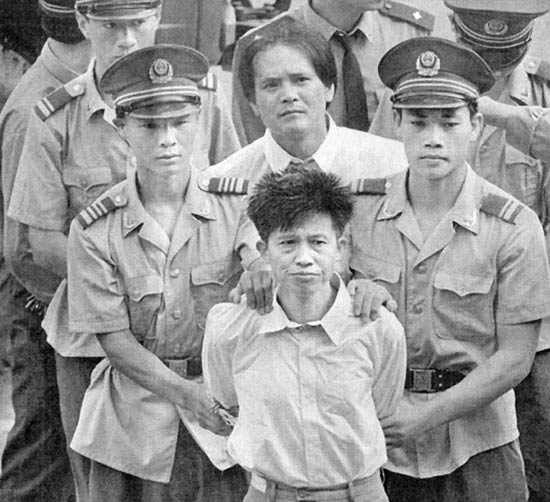 | |
| Thousands of people are executed every year in communist China. The bodies are then skinned and their kidneys removed. Once the organs have been removed, the bodies are then regarded as waste products, bagged up, and thrown onto a rubbish heap. |  |
As we have already seen, human life is probably the cheapest thing of all in China, and an average of 300 people a month are executed. The great majority of those who are executed have nobody to look out for their interests because families are often not told where prisoners are kept. They only learn their relatives have been killed after the event. Most of the time the families of those killed hesitate to ask for the body out of fear of retaliation. This then justifies the extraction of internal organs from almost all bodies. Harry Wu describes this fact with an example from his own life:
It is universally known that Mainland China is a society closely controlled by the communist party. In the People's Republic of China, as soon as one is labeled by the Beijing government as a "class enemy" or a "counterrevolutionary," almost all relatives keep aloof from him/her, or accuse and cast him/her aside… During my long nineteen years in the Laogai camp systems practically no relatives came to see me. I strongly believe that should I have been executed then, my body would have fallen under the category "nobody claims or family refuses to claim the body" and could have been "used" by the government for a profit.48
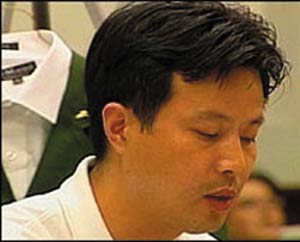 |
| Dr.Wang Guoqi |
What is more, even if families do hear about an execution, the Red Chinese government feels no great need to secure their permission. In one way or another, it will prevail upon them to donate their relative's organs. In 1997, in New York, one Chinese physician described how the internal organs of those condemned to death are removed without permission by the Chinese authorities:
Before Wu Hongda (Harry Wu) testified [in the United States], there was nothing like "consent," but now [the Chinese government] has certain formalities, and prisoners must go through the formalities willy-nilly, so when foreigners ask about this, we have something to tell them. Please don't worry!49
Harry Wu quoted a hospital cadre who had many times extracted organs at execution sites as saying, "A shot in [his] head, blow away his brain, and the guy is brain-dead. [He] has no more thinking, ceases to be a human being, just a thing, and we use the waste,"50revealing the attitude of the Chinese government. That is, killing prisoners is perfectly acceptable, and their bodies can be used for spare parts.
These organs are then sold by the state to hospitals abroad at extortionate prices. In fact, doctors in China advise patients from abroad to wait for the public execution season. Once organs have been removed from prisoners' bodies, the communist state says nothing about how and why they will be used. As always, Communist Party officials enjoy the highest priority. Then come foreign citizens or Chinese citizens living abroad. The local population can also make use of these organs only if they have the money to do so. Those with the very least access to these organs are the ordinary poor of society, no matter how great their need. That means the system is not for the benefit of humanity, but merely works to benefit Communist Party administrators and the elite. Most of the time the system goes ahead by stealing the organs of innocent people killed for having different beliefs or ideas than the party.
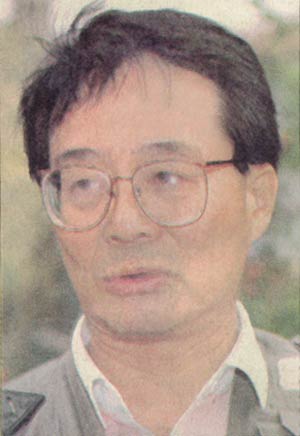 |
| Harry Wu |
Research has shown that some 20,000 kidney transplants were carried out in China between the early 1970s and the middle of 1995. In its 1996 report, Amnesty International said that the organs of 90 percent of people executed were removed. In its June 27, 2001, edition The Washington Post printed claims by a doctor involved in the organ trade, which underlined how widespread this trade was in China.
According to the story, burn specialist Wang Guoqi, participated in more than 100 operations during which organs were removed from the bodies of dead prisoners. Guoqi helped to collect prisoners' skin and corneas, and witnessed how organs were sold for enormous prices at the Tianjin Paramilitary Police General Brigade Hospital where he worked. Dr. Guoqi provided the time and date of the executions, the names of the doctors who took part in the operations, and the medical procedures involved and described in considerable detail how, after being killed, the prisoners would immediately be loaded onto ambulances and their organs removed. The bodies were later taken to the crematorium, where Dr. Guoqi and other doctors would strip off the corpses' skin. Dr. Guoqi explains that:
After all extractable tissues and organs were taken, what remained was an ugly heap of muscles, the blood vessels still bleeding, or all viscera exposed. Then the corpse was handed to the workers at the crematorium.51
Even worse, Chinese officials did not always wait for the prisoner to die before removing organs. One incident experienced by Dr. Guoqi illustrates this. An officer shot a prisoner, and although he was still alive, the doctors were ordered to take to the ambulance. As urologists immediately began removing his kidneys, Guoqi and the other burn surgeons harvested the skin. They then placed the remains of the half dead prisoner in a plastic bag and threw him onto a rubbish heap.52
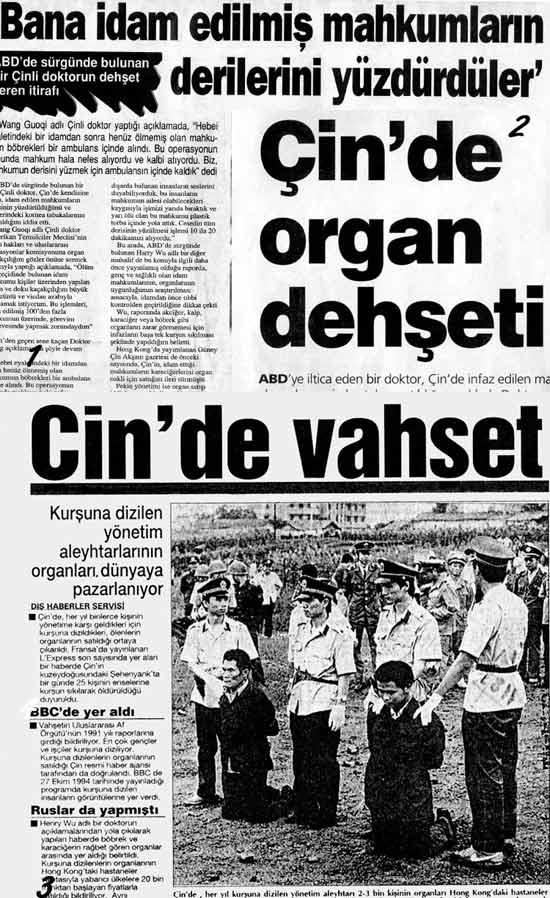 |
| 1) Milli Gazete 26.06.01 - "THEY MADE ME SKIN THE BODIES OF EXECUTED PRISONERS" The terrifying confession of a Chinese doctor in exile in the USA |
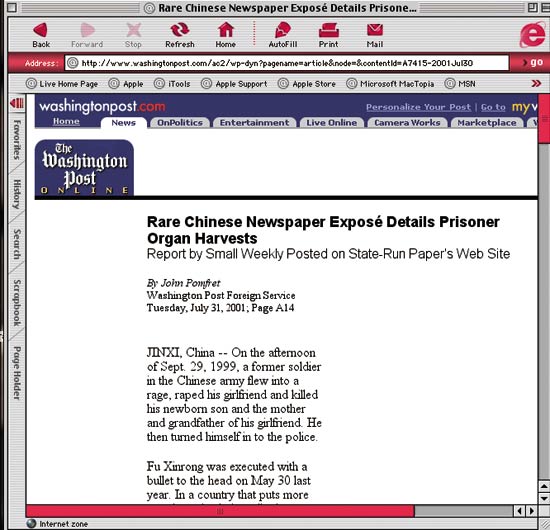 |
| An article called "Rare Chinese Newspaper Expose Details Prisoner Organ Harvests" in The Washington Post reported a story in the Chinese press about the sale of internal organs of people who had been executed. It concerned a former soldier who had been executed and his organs removed. It was first reported in a local Chinese paper, and then appeared in the Western media. (left) |
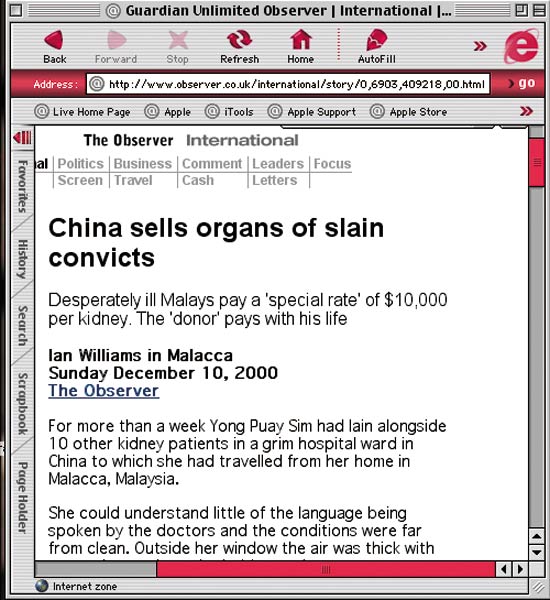 |
| To the left can be seen an article that appeared in The Observer called "China sells organs of slain convicts." The story reported that the organs were generally sold to rich patients from abroad. Based on a number of sources, the price of a kidney is in the region of $10,000. The fact that thousands of people are executed in China every year helps to show why the Chinese government is so insistent on continuing the organ trade. |
Family Planning, Red Chinese Style: Baby Murders
China has the largest population of any country in the world, and has long attached great importance to family planning in order to ensure social stability, enforced by a number of legal sanctions. Yet in any society that has no fear of Allah and where religious and spiritual values have no importance, it is easy for a system to turn truly horrifying. In China, instead of educating families and offering proper planning with a variety of medical alternatives, population control can be carried out even by killing babies while still in the mother's womb, or shortly after birth. This truly ghastly situation reveals the level of insensitivity and callousness of a society that lives with no notion of Allah, and has destroyed all its spiritual values, can descend into.
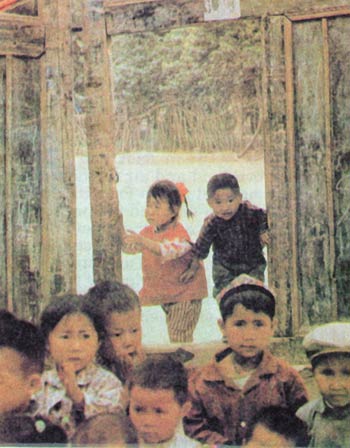 | 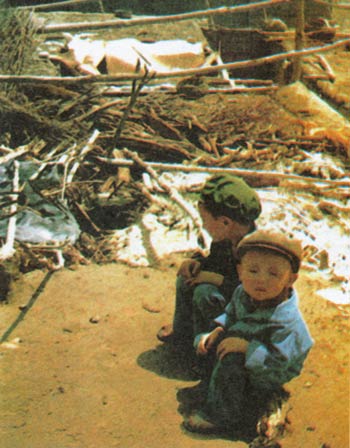 |
| Another aspect of Chinese brutality is the policy of forced abortions. Women who are not permitted to have children are either made to undergo abortions, even if they are in an advanced stage of pregnancy, or else their children are killed after birth. | |
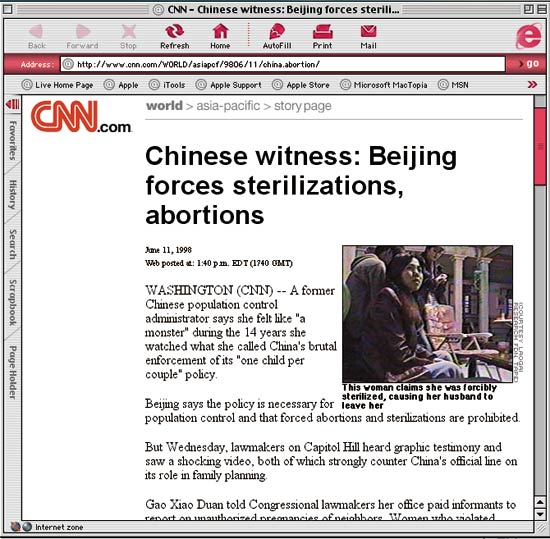 |
| A report on the famous news channel CNN described how Gao Xiao Duan had given evidence before the USA Senate Foreign Relations Department. Gao said that he had felt like a "monster" during the 14 years he served, and among the evidence he offered was a video cassette showing a center where women were forced to undergo abortions. Scenes from the video can be seen on the CNN web site. |
Nobody knows exactly how many women in China have had to undergo forcible abortions, but even if the figure were only 1 percent, that would still mean that millions of children had been murdered.
Gao Xiao Duan, the head of a "planned birth" office who sought asylum in the United States in 1998, made claims that once again drew the attention of world public opinion to the problem of abortion in China. At a press conference, Duan described to the whole world how he had witnessed women in China being forcibly sterilized to prevent them from having children, and how babies taken from their mother's wombs were left to die. In one incident he described, a nine-month pregnant woman's baby was taken away from her because her papers included the words "no birth certificate allowed":
In the operating room, I saw how the aborted child's lips were sucking, how its limbs were stretching. A doctor injected poison into its skull, and the child died and was thrown into the trash can.53
Another example of children being killed was an incident in the Caidian village in the province of Hubei, which was reported in the world media despite the restrictions on news and communications in China. The Times carried the story, which horrified the whole world:
China has been shaken by one of the most horrifying cases of official infanticide in recent memory after family planners drowned a healthy baby in front of its parents… She [the baby's mother] was forcibly injected with a saline solution to induce labor and kill the child. However, the baby was born healthy, to the surprise of family planning officials who had ordered the injection, which ordinarily destroys the infant's nervous system. Immediately after the birth, they ordered the father to kill the child outside the hospital. He refused to obey but was so scared of further punishment that he left the crying baby behind in an office building, where it was found by a doctor shortly afterwards. The doctor took the baby back to the hospital and reunited it with its mother and sent the family home. Five officials were waiting for them in their living room. During the ensuing argument, the officials grabbed the baby, dragged it out of the house and drowned it in a paddy field in front of its parents.54
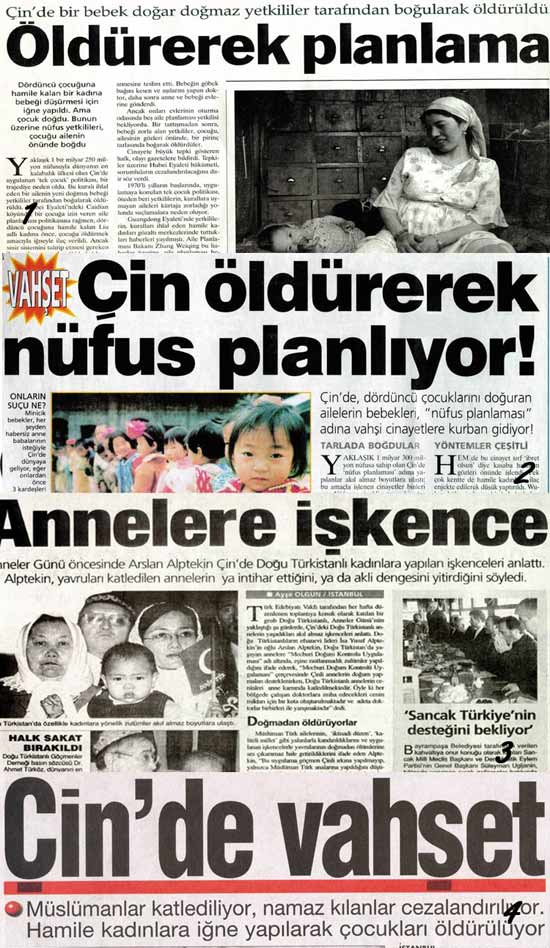 |
| Reports in the Turkish media describe the brutal family planning methods employed by China. |
| 1) Yeni Binyil 25.08.01 -AS SOON AS A BABY WAS BORN IN CHINA IT WAS STRANGLED BY OFFICIALS BIRTH PLANNING BY MURDER |
Another important issue to consider when evaluating the Chinese family planning policy, as implemented in East Turkestan in particular, is the justifications given by the Chinese government in defending that policy. The most striking of these is the slogan "Forming a better quality nation." One often comes across this Darwinist slogan in fascist regimes, and it is a sign of the implementation of the theory of eugenics in China, which first came to light in the nineteenth century. The theory of eugenics means elimination of the sick and handicapped and the "improvement" of a race by encouraging healthy individuals to multiply. The best known example was the systematic killing carried out by the Nazis in order to build the Aryan race. (For details see Harun Yahya's Fascism: The Bloody Ideology of Darwinism, Arastirma Publishing, Istanbul, 2002).
The way the policy is implemented with regards to Muslims takes on more serious dimensions when ruthlessness and cruelty are unchecked. From time to time Chinese families are permitted more than the allowed number of children (or only very mild punishments are imposed for having larger families than allowed). Yet Muslims are, under no circumstances, allowed to have more than one child. Muslim women pregnant with a second child may be removed from their homes, even during the eighth or ninth month of pregnancy, and the baby removed. In fact, Chinese units generally move around from village to village and town to town, loading women about to have a second child onto trucks. The abortions are carried out under primitive conditions, and as a result the mothers frequently die.
As a result of this policy, the birth rate in East Turkestan has declined by some 19 percent over the last nine years.55 Arslan Alptekin, the son of the late leader Isa Yusuf Alptekin, recounts the stories of two of the hundreds of women who have died after forced abortions:
On May 6, 1986, a 29-year-old woman by the name of Turahan Aysem died from loss of blood after an abortion had been performed on her. In August, 1997, a woman called Cholpanham from the Toksu district of East Turkestan was forced to have an abortion because she was pregnant, and her husband was fined 3,000 yuan … Taken from her home by force, the woman fled the clinic at the first opportunity, took shelter in a cemetery and gave birth by herself. She was then taken home by another individual. However, she was detained again following a tip-off, and the baby was killed by being plunged into hot water at the police station she was taken to. Unable to bear the agony of that, the mother also died.56
One official from East Turkestan who did not want to identified said that, in a town of 200,000 people, some 35,000 pregnant women were subjected to government "checks", and 686 were obliged to have abortions. 993 women were forced to discontinue their pregnancies, and 10,708 women were forced to undergo sterilization. Again, according to the same official, in another town of 180,000 people only about 1,000 women were allowed to give birth (one woman out of every 35). At the same time, 40 people were sacked from their jobs because their wives were pregnant.57
Chinese Families Who Kill Their Children Just Because They Are Girls |
| Ever since the communists took power in China, the strict measures they have taken against religious teaching and religious life have led the Chinese people to undergo a material and spiritual collapse. The resemblance between this state of affairs in which human beings are regarded as a group of animals (and as a result violence is seen as something completely normal) and the atheist societies described in the Qur'an is most striking. One of these similarities is the way that people who have female babies kill them because of the low esteem in which their society holds daughters. This brutal practice is described in the Qur'an as a feature of ignorant societies, and is widespread today in China, a country that has rejected belief in Allah. When compulsory family planning policies are combined with China's anti-religious customs, the result is that a great many families killing their baby daughters. Chinese families are legally allowed only one child, and if their first baby is a girl, they frequently leave the child to die. The reason is because, according to Chinese custom, male children are more valuable, and if their first child is a girl, they will be unable to have a son. As a result families kill the daughter to prevent this from happening. It is estimated that some 1 million baby girls are abandoned to die in China every year. 1 In the Qur'an, however, it is stated that everyone, male and female, is equal in the Sight of Allah. Allah has revealed that the only measure of superiority between people lies in godliness, avoiding all sin and disobedience that might harm people in the hereafter and lead to eternal torment: Mankind! We created you from a male and female, and made you into peoples and tribes so that you might come to know each other. The noblest among you in Allah's Sight is the best in conduct. Allah is All- Knowing, All-Aware. (Surat al-Hujurat: 13) It is morality, not the gender of children, that matters to a believer. In societies that do not recognize Allah, however, that have no fear of Him, nor belief in the hereafter, terrible crimes such as killing baby girls just because they are female can easily take place, and with the passage of time can even 201 Harun Yahya - Adnan Oktar turn into a custom. However, discriminating between male and female children is fiercely condemned in the Qur'an, and Allah has described the situation of those families that do so: When one of them is given the good news of a baby girl, his face darkens and he is furious. He hides away from people because of the evil of the good news he has been given. Should he keep her ignominiously or bury her in the earth? What an evil judgment they make! Those who do not believe in the hereafter have an evil likeness. Allah's is the Highest Likeness. He is the Almighty, the All-Wise.(Surat an-Nahl: 58-60) 1. Yeni Binyil (Turkish Daily), August 25, 2000. |
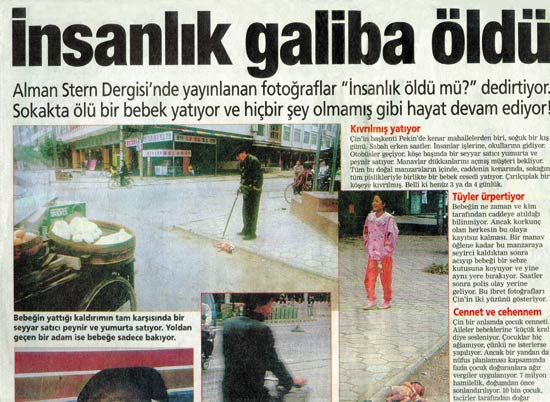 |
| Posta 16.02.01 |
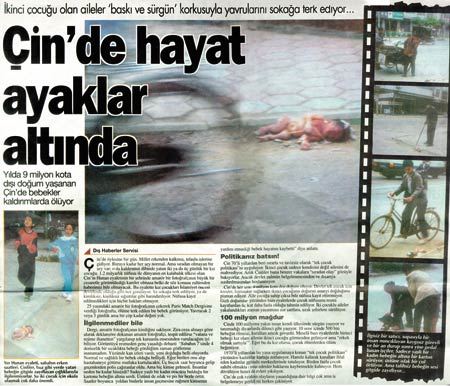 |
| Türkiye 15.05.01 |
"Such was the case with Pharaoh's people and those before them. They denied their Lord's Signs so We destroyed them for their wrong actions. We drowned Pharaoh's people. All of them were wrongdoers."
(Surat al- Anfal: 54-55)
Similar examples of such brutal family planning methods have been employed by dictators and despots in order to impose their own ideologies and secure their own regimes. One such was Pharaoh, who has gone down in history for the suffering he inflicted on a people who refused to abide by his false man-made religion, but had faith in Allah. Just like the atheist leaders in Red China, Pharaoh tried to prevent the number of believers growing and the weakening of his own authority over them by oppressing them and killing their children. This is described in the Qur'an:
Pharaoh exalted himself arrogantly in the land and divided its people into camps, oppressing one group of them by slaughtering their sons and letting their women live. He was one of the corrupters. (Surat al-Qasas: 4)
However, Allah punished Pharaoh for his brutality, causing him to die in a manner that served as a lesson to all. There is no doubt that those who share a similar mindset to Pharaoh and refuse to abandon their own cruel ways will meet a similar fate to those who have gone before them.
Chinese Migration to East Turkestan
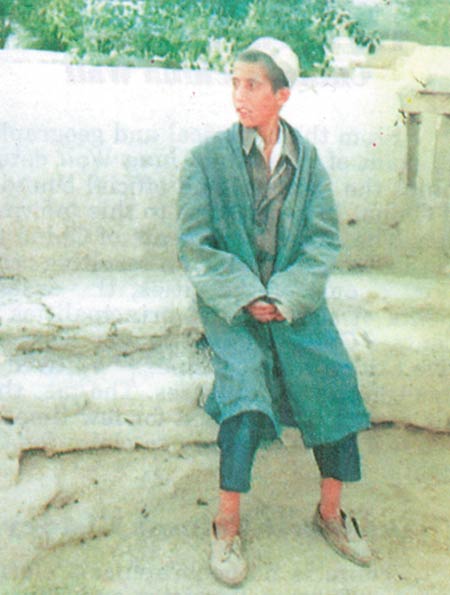 |
One of the assimilation policies implemented by China in East Turkestan is the systematic, organized migration of Chinese people to the region. This is actually the final stage of China's great plan for East Turkestan. After Muslims of East Turkestan are arrested, martyred, sent to labor camps and forced to leave their land and, by encouraging Chinese settlement, they gradually reduce the local Muslims population. In this way, the Muslims who now represent the majority in East Turkestan will be systematically reduced in numbers, and will eventually have no claim to their own land.
When Mao seized power in China, Uighur Turks made up 93 percent of the population of East Turkestan, and Chinese only 6-7 percent. Over the 50 years that followed, the Chinese population has risen to 42 percent. It is estimated there are now more than 6 million Chinese in East Turkestan, whereas 50 years ago there had been fewer than 300,000. Policies, such as improving agriculture and protecting migrants, were brought in at the beginning of the 1950s to support the Chinese settlers in East Turkestan. The rise in ethnic tensions in the region at the beginning of the 1980s was accompanied by a relaxing in official policies in support of Chinese migration. That did not mean, however, that the government had abandoned its aim of turning the region into a Chinese province. This time, the Chinese element of the population was raised, as a result of the number of qualified personnel moved in to man the factories installed to serve the Chinese economy in East Turkestan.
China's policy of eroding the Muslim Turkish presence had the effect of making Muslims second class citizens in their own land in the face of the Chinese settlers. The settlers who poured into the country were placed in the most productive areas, and the local people were forced to move into arid ones. The Chinese are able to enjoy all political, economic, technological and social benefits, while the Muslims have grown ever poorer. The difference in the living standards of the local Muslims and the Chinese settlers is described by Arslan Alptekin:
The Turks are made to do the very hardest jobs for subsistence wages, while the Chinese migrants are given special political and economic privileges. The Muslim people live in rural areas or in shanty towns, while special settlement areas with full infrastructure have been built for the Chinese migrants. Social inequality is weighted against the Turkish people from all points of view.58
China's attempts to increase the number of Chinese in East Turkestan were sped up in the 1990s. In order to justify that increase, the Red Chinese government speaks about various economic investments, and special projects, most of which have been developed solely with that in mind. For instance, the October, 1992, edition of the Hong Kong magazine Trend disclosed a secret program which planned the settlement of 5 million Chinese in East Turkestan by the year 2000. This figure does not include the People's Liberation Army units who are permanently stationed there, qualified Chinese personnel, or convicted Chinese criminals who have been deliberately sent to the region.59
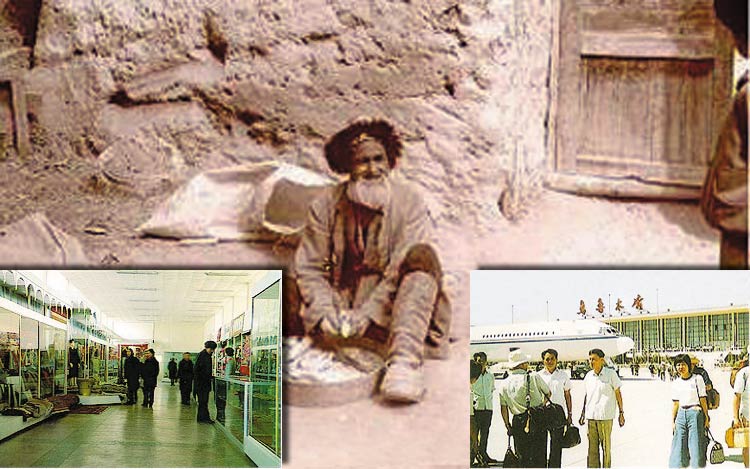 |
| There is a huge gulf between the living standards of the Chinese people living in East Turkestan and the Muslim Uighurs. This is a result of the Chinese policy of oppressing the Muslim population. |
The Role of the Bin Tuan in East Turkestan
Following the communist takeover, one of the most important elements of Mao's Great Leap Forward was the investments made in ethnically differentiated regions such as East Turkestan. Within the framework of the program, the Xinjiang Production and Construction Corps (XPCC), known as the Bin tuan, was set up in the 1950s with the alleged purpose of developing East Turkestan. The so-called civilian members of that force were supposed to reconstruct this backward area of China. As a result, ethnic Chinese were brought in from all parts of the country and began working in the camps that had been set up.
As the military units that had been brought in to quell the Muslim uprising against the Chinese administration found they had less to do, the unit set up to support agricultural development programs was dissolved in 1975. In 1981, the Bin tuan was reformed under the peculiar name "Xth Agricultural Division," and is still active today. It consists of some 2.28 million people, 1 million of whom are workers. Its responsibilities include ruthlessly suppressing Muslim independence movements, running the laogai labor camps, and bringing in hundreds of thousands of Chinese criminals and settling them in East Turkestan.
As many academics have revealed, the Bin tuan's real purpose is the colonialization of East Turkestan. In his book New Ghosts Old Ghosts – Prisons and Labor Reform Camps in China, for instance, James D. Seymour of Columbia University's East Asian Institute and Richard Anderson provide considerable detail about the Bin tuan, and unravel the links between the organization and the prisons and labor camps. Bin tuan is established along the border separating the north and south of East Turkestan. It has jurisdiction over several million hectares of land and is largely made up of ethnic Chinese. It is independent of the Uighur Autonomous Administration and has its own security forces, courts, and agricultural and industrial enterprises. It also runs a large network of labor camps and prisons.60
More surprisingly, these so-called "production units" of Red China that violate human rights are financed by the World Bank. China set out a number of programs under the Great Leap Forward and secured World Bank support for them. A number of work areas were to be set up, allegedly to regenerate East Turkestan and help it to develop, which would both help the economy and create employment for the local population. Yet, the project actually developed in a very different way than the paper plan. These work areas were labor camps to punish China's criminals, principally Muslims. The revenues obtained went, not to the local economy, but to the central economy. That was the true face of the Great Leap Forward project backed by the World Bank. A 1998 report by Dr. Paul George emphasized how Harry Wu described the position:
The World Bank became embroiled in a major controversy over the XPCC in 1996 when the leading Chinese dissident, Harry Wu, testified before the United States Senate Foreign Relations Committee that the organization was running 14 forced labour camps, or Laogai, in Xinjiang under Bank supported development projects. The World Bank loans had been aimed at helping the Uighurs but, according to testimony from two Uighur former officials from the XPCC, had actually strengthened government control over the region and facilitated a crackdown against anti-Chinese dissidents.61
"So fear Allah and obey me. Do not obey the orders of the profligate, those who corrupt the earth and do not put things right."
(Surat ash-Shu'ara': 150-152)
Officials estimate that, in the years that followed, the amount of land controlled by the Bin tuan actually tripled. That is because an independent Chinese province was slowly emerging within East Turkestan. Moreover, China always looked on the organization as one of the basic elements in ensuring stability in East Turkestan. One important example of this was the way that, after an uprising in Gulja in 1997, the Bin tuan 4th Unit was positioned in the region and used to capture and arrest Muslims. Still today the organization is still performing its role of intimidating Muslims.
The Red Chinese regime sends hundreds of thousands of people convicted of murder, rape and theft to East Turkestan, but those who have served their sentences are still not allowed to return to China. The great majority of these people are settled on land that Muslims have been thrown off. Such people are known as "reformed farmers," and are allowed to bring their families to join them, and thus to settle in East Turkestan.
Together with a rise in the numbers of these so-called reformed farmers, the crime rate in East Turkestan has also risen, particularly murder, rape, theft and child kidnapping against the Muslim population. Very seldom are kidnapped children found. The Muslim people fear that such children are either taken to China and sold, or else martyred and their bodies used in the organ trade. The police, who are again mainly Chinese, refuse to take Muslims' complaints seriously, and often do little to properly protect them.62
What we have seen in considerable detail are examples of Darwinist-communist brutality. Women forced to undergo abortions and being subjected to inhuman practices, (such as the killing of babies in their cradles under the pretext of population control) and the use of people as guinea pigs in nuclear tests (which will be examined in more detail in the later sections of the book) are all the result of the Darwinist idea that regards people as animals. Such cruelty is the implementation in a communist state of the Darwinist suggestion that sees life as a struggle of self interest. It can only be brought to an end when that dark ideology is wiped off the face of the earth.
Atheist Zionists Arm the Chinese Army |
| When one compares China's actions in East Turkestan with those of atheist Zionists in Palestine, one encounters a number of similarities, even though the former has a communist form of government and the latter a capitalist one. Both are occupying lands that belong to Muslims, and the Muslim populations are forced to live under military, political and economic occupation. Torture, groundless detentions, massacre and slaughter are some of the commonest words in both regions. This similarity between China and Israel has formed the basis of cooperation between them. China obtains some weapons for its People's Liberation Army from Israel. It is of course natural for there to be military cooperation and joint work on technical matters between two countries. But the important thing here is that these weapons are being used unjustly, illegally and ruthlessly against innocent Muslims. The military relationship between China and Israel began in the first half of the 1970s. Israel first helped the Chinese army update its old Soviet weapons. After the mid-1980s, official contact was established between the Chinese and Israeli ambassadors at the United Nations. This relationship was furthered under such pretexts as "agricultural cooperation," but what really kept it on its feet were the arms China secured from Israel. The considerable quantities of arms sales by Israel to China were carried out by Israeli businessman Shaul Eisenberg, who worked for Mossad. After everything had been placed on a firm footing, secret agreements and delivery were the responsibility of Mossad.1 During a visit by Yitzhak Rabin to Beijing in 1993, cooperation agreements were signed between Israel and China on nuclear testing and technology. The scale of the military cooperation between the two countries, which continued to develop further in the ensuing years, was discussed by the Israeli newspaper Jerusalem Post in its September 10, 1998, issue: Israel's got the defense technology. China wants it. The Chinese seem to value the Jewish mind highly. But what they clearly want is "technology," and the high-tech weapons systems Jewish minds in Israel have developed during 50 years of conflict and several wars… Israel's defense ties with China go back to the late 1970s, way before diplomatic relations were established in 1992… Hundreds of skilled Israeli technicians, engineers and weapons experts began surfacing in China - having reportedly entered using passports of various countries - and were soon busy at work. The Sino-Israel partnership only became public knowledge during a military parade in Beijing, when Western military attaches noticed that the tanks being displayed were equipped with an Israeli-invented "thermal fume-extraction sleeve" on the barrels of their cannons.2 At the basis of this rapprochement lies the unease felt by China at the rise of Islam in East Turkestan or the regions around it. In the Washington Report on Middle East Affairs, it was reported that the Chinese-Israeli alliance was based on China's attempts to "neutralize Islamic movements", and that China was alarmed at the presence of some 20 million Muslims in East Turkestan.3 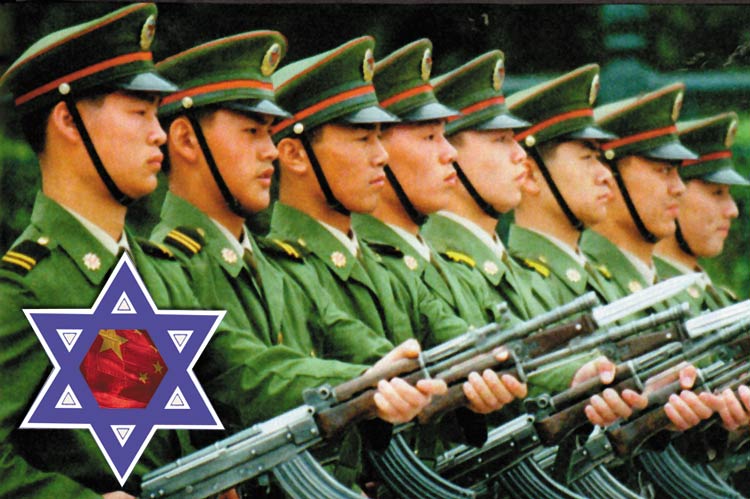 |
| 1. Dan Raviv, Yossi Melman, Every Spice A Prince: The Complete Story of Israel's Intelligence Community, Boston, Houghton Mifflin Company, 1991, page 346. |
China's Israeli Model
One of the projects prepared by China to settle another 5 million Chinese in East Turkestan was described in the International Herald Tribune. The report not only discussed the project itself, but also drew attention to the similarities between the practices in China and Israel. Under the project, a 14 billion dollar investment was to be made in a region in which Chinese people had been a minority for hundreds of years (in other words, East Turkestan), and this would allow the agricultural and underground resources of the region to be used at full capacity by the Chinese economy.
The project was actually a cunning way of disguising further Chinese migration into the region. Despite all the investments and advantages bestowed on Chinese migrants, their numbers had actually dropped. The Chinese government therefore began to establish Chinese settlements in exactly the same way that Israel is now doing in Palestinian territory. In order to make migration seem more attractive to Chinese people facing hunger and poverty in other regions, a number of economic investments were planned. The aim was to prevent a return wave of migration back to China and to tilt the population balance in China's favor.
As we have seen, the plan bore all the signs of colonialism espoused by certain atheist Zionists. It appears that not only do atheist Zionists support China by selling it arms and providing intelligence, but they also recommend that Red China employ the same methods of violence and repression that they used against the Muslims of Palestine. Red China has occupied a land that does not belong to it, and in the face of protests from the whole world, intends to eliminate the Muslims from the land it has occupied by bringing in its own settlers.
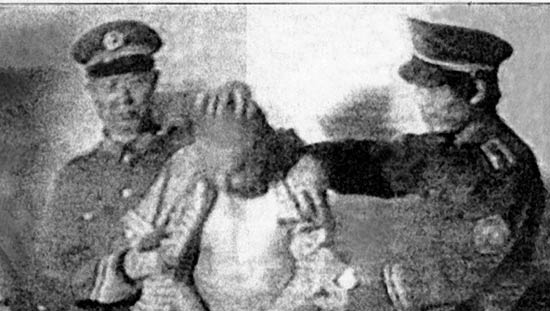 |
| The above picture from the French magazine Le Figaro documents the cruelty and torture inflicted on the people of East Turkestan by the Chinese police. |
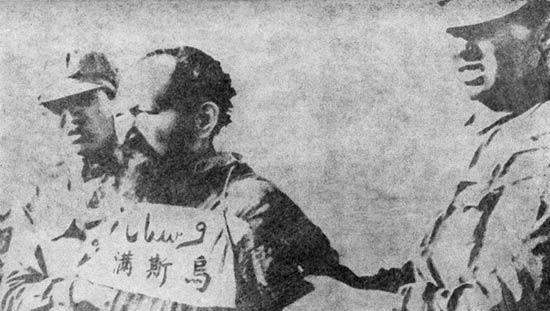 |
| Those who protest against the Chinese oppression of the people of East Turkestan are brought before the public and humiliated by Chinese troops. (above) This is generally followed by torture and death. |
The historian Michael Dillon, who teaches modern Chinese history at Britain's University of Durham, offered the following analysis of the intention behind this policy of China's in an article of his titled "China Goes West: Laudable Development? Ethnic Provocation?":
China is embarking on an ambitious project to develop its vast western regions, for centuries the poorest and least densely inhabited areas of the country. The overt motivation is an economic one, specifically the relief of poverty. But the "Go West" (Xibu da kaifa) project could dramatically alter the ethnic and social balance of the region and is likely to increase inter-ethnic conflict.63
As Dillon stated, the project is one of modern colonialism, aimed at increasing ethnic conflict in the region and thus justifying a policy of oppression against the Muslims of East Turkestan. Under the guise of economic reconstruction, China is also trying to finance this project with Western capital. Dillon describes the situation in these words:
In these tense circumstances, economic development can never be merely a neutral device for the alleviation of poverty. It is a conscious political tool, designed to stabilize the western regions, which borders with Russia, Mongolia, Kazakhstan, Kyrgyzstan, Tajikistan, Afghanistan, India and Pakistan. Stabilization necessitates Chinese government suppression, by political or military means, of movements demanding autonomy or independence. The Chinese government is thus caught in a bind. China cannot attract foreign capital [to] China's West if there is constant danger of riots, demonstrations and sabotage. 64
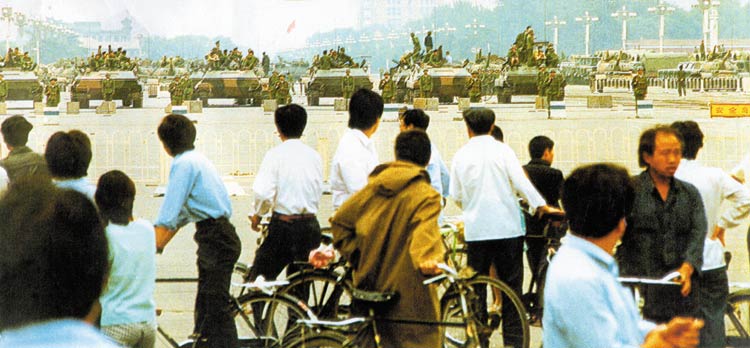 |
| Die wirtschaftliche Einkesselung Ostturkestans durch das kommunistische China führte dazu, dass die Bevölkerung in Not und Armut lebt. |
The words "economic reconstruction," are actually a tool employed by China to attract foreign capital into the region. The real aim is to uphold a system and its component bodies that will allow it to exploit the region for its own interests. As we saw in the preceding section, China has managed to take advantage of foreign capital under a number of pretexts, and used it to oppress the Muslims of East Turkestan and to violate their human rights in a most ruthless manner. For instance, a similar reconstruction plan was implemented in Kashgar, and Muslim farmers were forced off their own lands and obliged to work elsewhere. In fact, every initiative that Red China has undertaken to pull the wool over the eyes of the West has resulted in greater oppression of Muslims, a rise in violence, and in their being forced to give up their land to the Chinese.
The Autonomous Administration Deception
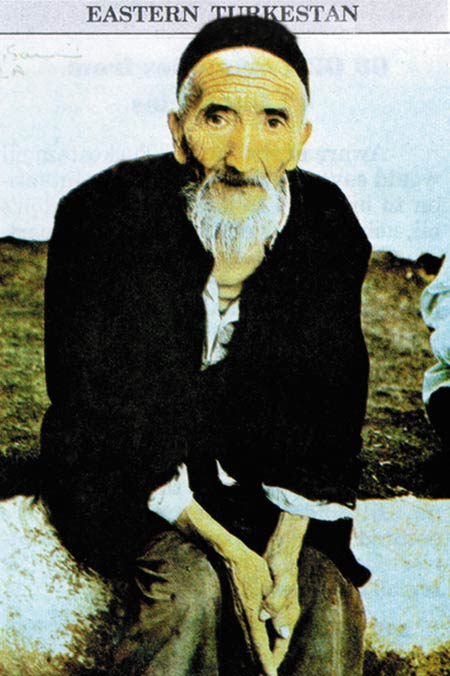 |
East Turkestan is today known in political literature as the "Uighur Autonomous Region of Sinkiang." The concept of "autonomous administration" means a form of government that answers not to the wishes and instructions of central administration, but rather to the needs and wishes of the majority of the population, and is indeed semi-independent. However, the form of autonomous administration practiced in East Turkestan bears little similarity to this generally accepted definition. Although Uighur Turks are found in the various administrative bodies in the region, it is impossible for them to act in the light of the wishes and needs of the people, because, although they may be in charge of offices, they actually enjoy little real authority.
Any administrator who tries to act in the light of the people's wishes and needs is often punished by being removed from his post. In the event of any dispute between a Chinese administrator and an Uighur one, the East Turkestanian is usually punished.
Autonomous administration, authority, equality between different ethnic groups, minority rights, and other rights that are protected by law, are all regularly being violated by Beijing (which prepared the laws). All authority lies in the hands of the Chinese. The political, economic, supervisory and military decision-making powers of those ethnic groups that are appointed to autonomous administration bodies as puppets are all actually under the control of the Chinese Communist Party. The article "Pekin's Campaign to Destroy Uighur Culture" by the German writer Ulrich Schmid sets out the position in these terms:
In other words, the real pattern of power here in China's most northwesterly province differs vastly from the rosy façade… in China the real power lies not with the organs of government but with the leadership of the Communist Party at various levels.65
In a report about East Turkestan, Der Spiegel magazine said that the area was a Chinese colony rather than having an autonomous administration, and that Chinese administrators were insensitive to the Muslim Uighur population:
The Chinese rule in Xinjiang is in every respect a colonial phenomenon. Although they have lived in this country for decades none of the Chinese officials speak the local language. They are not interested in the country where they earn their living. They undermine the local peoples' customs. In brief, the Chinese officials hate the local people...66
Another indication that East Turkestan is not autonomous, but rather a colonized country, is the fact that the people under the administration are not free to travel as they wish in their own land. Despite Article 5 of the United Nations Committee on the Elimination of Discrimination Treaty, the Chinese government restricts freedom of movement in East Turkestan. People in East Turkestan are not allowed to migrate from one village to another, or to another province or city at will, but need to obtain permission first. That is why 90 percent of the East Turkestan population live in rural areas. Restrictions are imposed on their right to travel abroad. Even though they may have no record of any kind, most people are not allowed to go abroad (or even to travel to other regions in China).
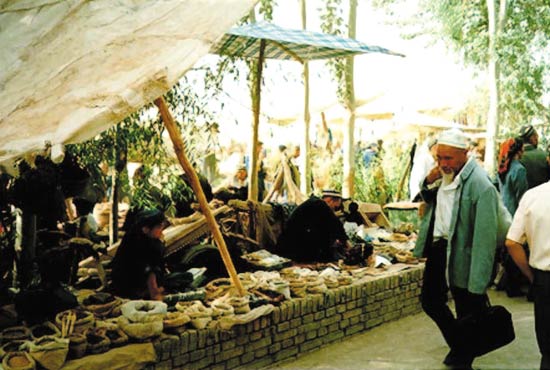 |
| Communist China's economic encirclement of East Turkestan has led to the local population living in misery and poverty. |
 |
The list of similar methods of oppression is long. Another example is, East Turkestan Muslims are not allowed to go on the hajj pilgrimage, which is an obligation incumbent on all able Muslims. When 1,200 Uighurs were ready to go abroad to participate in the hajj in 1999, their passports were seized by the police, and 122 elderly Uighurs who objected were detained.67
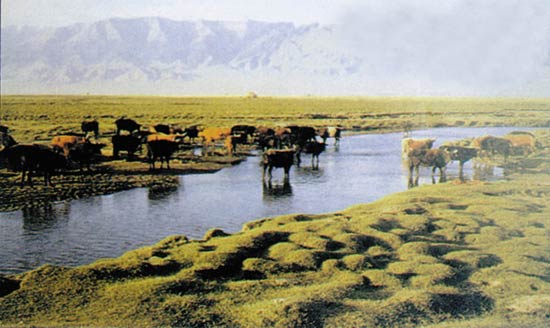 |
| The area around Lop Nor, the most important lake in East Turkestan, has the general appearance of a swamp. The people living there are forced to battle with the most difficult conditions. |
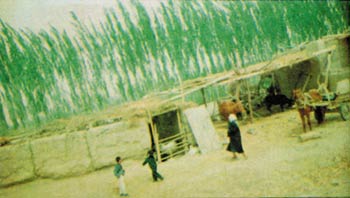 |
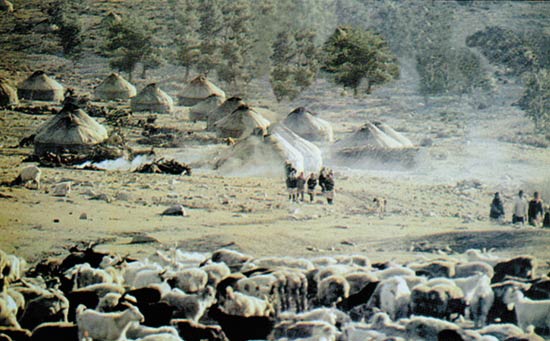 |
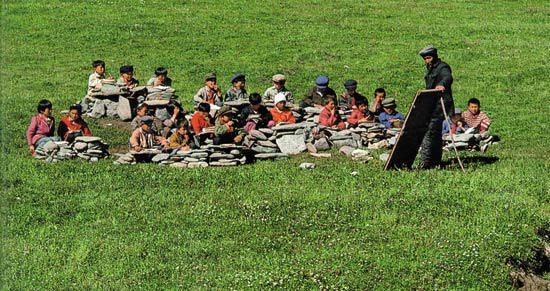 |
 |  |
| China's constantly sending Chinese migrants to East Turkestan results in the Muslim population having to leave their homes and resettle in rural areas. The Muslims enjoy very few possibilities, and are able to educate their children under the most difficult conditions. |  |
Economic Pressure in East Turkestan
Despite all its underground wealth and fertile land, East Turkestan is currently one of the poorest regions in China. This contradiction can be easier understood by bearing in mind that East Turkestan is a supplier of raw materials for the Chinese economy. Such underground resources as uranium, natural gas, oil, and gold are transferred from East Turkestan to China, and all aspects of the use of these resources are under central government control. The Muslims of East Turkestan, to whom those resources actually belong, cannot even find out the production levels, nor what their share of the profit actually is.
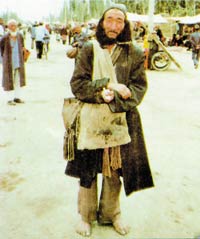 | 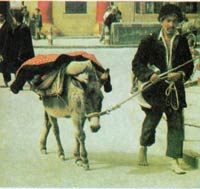 |
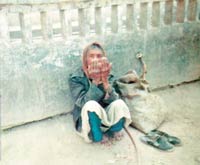 | |
| All of East Turkestan's natural wealth is exploited by China, and another factor the local population has to battle with is hunger and poverty. | |
A brief look at the statistics will suffice to demonstrate the vital importance to China of East Turkestan's natural resources. In the first quarter of 1989, East Turkestan sent 7.68 million barrels of crude oil, 906 thousand tons of coal, and 444 thousand tons of raw salt to China.68 In 1993, 10.4 million metric tons of crude oil were extracted in East Turkestan, yet all the profit went to China.69 China exploits East Turkestan's resources for its own economy and citizens, and condemns the Muslim population to poverty and hunger.
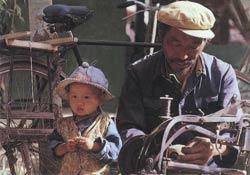 | 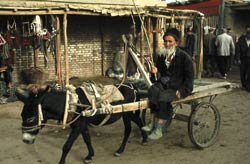 |
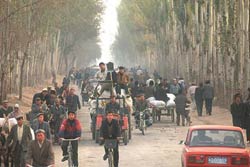 | 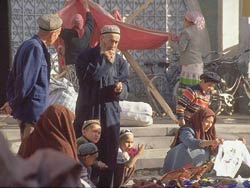 |
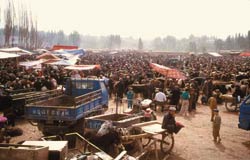 | The Muslim Population is Condemned to Poverty While Many Chinese Live in Plenty |
Economic oppression is an important part of the genocide that China is carrying out in East Turkestan. Most of the East Turkestan population are today living in poverty, and more than 80 percent subsist below the minimum dietary threshold.70 On account of the discriminatory policies that are also pursued in the field of education, Muslim Uighurs are unable to educate themselves to find better employment.
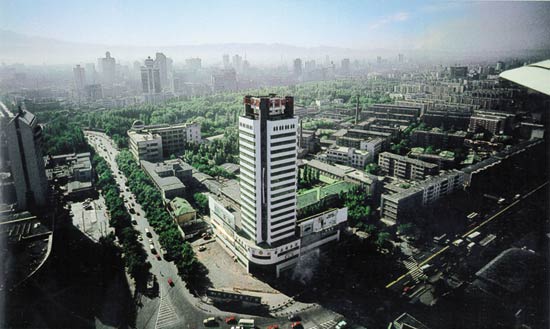 |
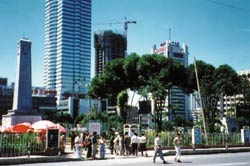 | 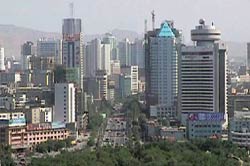 |
| There is a huge difference in living standards in those areas of East Turkestan inhabited by Chinese settlers and those where the Uighur Turks form the majority. Urumchi (above), for instance, the capital, with its large numbers of Chinese, looks just like a modern city, while Kashgar, with its mainly Muslim population (left) suffers from lack of infrastructure and poverty caused by the exploitation of its natural resources. Most of the people have great difficulties making ends meet, and transportation is by horse and cart over earth tracks. The basic reason for this is the continuing cruelty inflicted by the Chinese government on the people of East Turkestan for more than half a century. The people have had all their economic, political and legal rights taken away from them, and are forced to live within the parameters set out for them by the Communist Party. Few Muslims live in Urumchi, with its luxury hotels, shopping centers, plazas and motorways, and those who do run small restaurants or work as cleaners or janitors etc. The people have no right to invest or engage in commerce, and are therefore restricted to certain kinds of jobs. This shows that the people of East Turkestan, the cradle of a deep-rooted civilization which enjoys rich natural resources, are treated as second-class citizens in their own land. | |
 |
| The Uighur farmers spend most of their time working like slaves in their own land, and are impoverished in the midst of plenty. |
Since almost all areas of employment in East Turkestan are in Chinese hands, the Muslim population is facing a severe unemployment problem. Yet despite this, the Chinese government still keeps transferring people from the west of China to work in the region. In this way the government is not only trying to alter the population balance in its own favor, but is also trying to maintain control of the East Turkestan economy. The statistics reveal the scale of China's repressive policies: Only ten percent of the 200,000 industrial workers around the capital, Urumchi, are Uighurs, the rest are Chinese. Only 10 percent of the workers in a textile plant near Urumchi are Uighurs. The number of Uighurs in one textile plant near Kashgar which employs 12,000 people is only 800. A tractor factory near Urumchi has 2,100 workers, yet only 13 of these are Uighurs. A new petro-chemical plant was opened in the city of Poskam in 1986, and all of the 2,200 workers are Chinese.71
 |
Nuclear Casualty |
| Akit - 12.10.00 - China's illegal nuclear tests have caused the people of East Turkestan to contract long-term diseases from the effects of radiation. |
The number of Chinese oil companies coming to East Turkestan in search of oil has grown rapidly since 1989, although almost all of the 20,000 workers employed in the Tarim Basin alone were selected from among the Chinese population.72 This discriminatory policy against the people of East Turkestan has gone so far that Chinese people who know nothing about the region's history, culture or civilization have started working there as tourist guides. In this way, China is able to keep control of the information imparted to those tourists who do visit the region, and in this way prevent the Muslims of East Turkestan from having their voices heard.
Muslims who make a living from agriculture have been made to pay higher taxes under new laws passed by Red China. In some regions, farmers are made to sell their produce to the state for half the normal price, whereas higher prices are paid to Chinese farmers. Some lands belonging to Muslim farmers are compulsorily purchased, and these people are then obliged to join the ranks of the unemployed and the poor. The unpaid compulsory service that the Muslims of East Turkestan are compelled to provide also makes life even harder for the already impoverished farmers. Under this unjust system, Muslim Uighurs in East Turkestan are forced to work on the job given them by the Communist Party without pay for a month, or a month and a half, every year. Yet the Chinese, in flagrant violation of the period set out in the relevant law, make the local population (and the farmers in particular) work unpaid for five or six months a year. The Turkish farmers spend most of their time working like slaves on their own land, and live in poverty in the midst of great wealth.73
China's Nuclear Test Field: East Turkestan
Despite the opposition of a great many international organizations, China has carried out a number of nuclear tests in the Lop Nor district of East Turkestan since 1961. These tests lead to major destruction of the natural environment in the region, and severe damage to its ecological balance endangering human life, polluting drinking water and food supplies. As a result, thousands of animals have perished and a large number of people have died, and there has been a huge increase in the number of babies born with deformities.
Although the number of those affected by the nuclear tests in East Turkestan has not been officially revealed, it is estimated that some 210,000 people have died from radioactive fallout. Radioactive fallout also gives rise to cancer, and a 10 percent rise in the number of incidents of cancer has been recorded.74 In a 1993 report, released by the Registry of the People's Hospital of Urumchi, no more than a handful of fatal incidents of cancer were recorded in the 1960s, but this has risen to dozens by the 1970s. A later hospital report stated that new reports of cancer in this hospital number at least 70 a day out of an average 1,500 daily visits.75 Even worse is the fact that poor medical aid is provided for the region in which cancer and other diseases caused by radioactive pollution are rife.
With their deeds and great cruelty, Mao and his followers are actually an example of the mentality that has rejected the existence of Allah down the ages. From this point of view, Mao's practices bear similarities to the polytheists of Mecca who expelled the companions of the Prophet (may Allah bless him and grant him peace) because of their belief, Nimrod who threw the Prophet Abraham, peace be upon him, into the flames because he rejected the idols of the community in which he lived, and Pharaoh who killed the children of the People of Israel because they refused to accept his so-called divinity (surely Allah is beyond that) and, instead, remained loyal to the Prophet Moses, peace be upon him.
The common feature of all these despots denying Allah was that they regarded the true religion and those who lived by it as their greatest enemies. That enmity then turns into terrible anger and hatred, and they try to turn the believers from the true path by means of unbelievable torture and oppression. Yet they forget one thing:
Allah is the Lord of all, and that the victory belongs to Allah and those who believe in Him. That is a law of Allah, and will apply in the same way in the future as it did in the past. By the will of Allah, believers will "certainly be given victory." (Surat as-Saffat: 172)
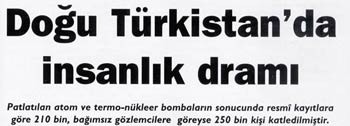 | 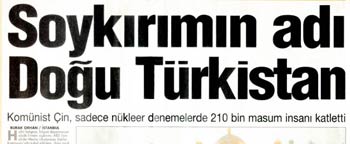 |
| Eğitim Bilim Journal - 11.00 - THE HUMAN TRAGEDY IN EAST TURKESTAN According to official figures, 210,000 people have been martyred as a result of atom and thermo-nuclear bomb tests. Independent observers put the figure at 250,000. | Akit - 12.10.00 - EAST TURKESTAN, ANOTHER WORD FOR GENOCIDE Communist China has martyred 210,000 innocent people in nuclear tests alone. |
Footnotes
25. The Independent, October 20, 1988 ![]()
26. Micheal Hoffman, "World Forgets Beijing's Uighur Victims," Mainichi Daily News, June 29, 2000 ![]()
27. Killing By Quota, Killing for Profit: Executions and Transplants in China, Laogai ResearchFoundation, www.laogai.org/reports (emphasis added) ![]()
28. Killing by Quota, Killing for Profit: Executions anda Transplants in China, Laogai Research Foundation, www.laogai.org/reports (emphasis added) ![]()
29. Angus Roxburgh, "How Russia Faced Its Dark Past," BBC News Online news.bbc.co.uk/mpapps/pagetools/print/news.bbc.co.uk/2/hi/europe/2821281.stm (emphasis added) ![]()
30. Undisguised Killing: Public Executions in China, Laogai Research Foundation Special Report, www.laogai.org/reports/killing.htm (emphasis added) ![]()
31. Undisguised Killing: Public Executions in China, Laogai Research Foundation Special Report, www.laogai.org/reports/killing.htm ![]()
32. Myriam Marquez, "Let's See Beijing's Butchers Are Really Good Sports," Orlando Sentinel, July 16, 2001 ![]()
33. Gross Violations of Human Rights in the Xinjiang Uighur Autonomous Region, Amnesty International Report, April 1, 1999 ![]()
34. Gross Violations of Human Rights in the Xinjiang Uighur Autonomous Region, Amnesty International Report, April 1, 1999 (emphasis added) ![]()
35. Gross Violations of Human Rights in the Xinjiang Uighur Autonomous Region, Amnesty International Report, April 1, 1999 (emphasis added) ![]()
36. Gross Violations of Human Rights in the Xinjiang Uighur Autonomous Region, Amnesty International Report, April 1, 1999 (emphasis added) ![]()
37. Dogu Turkistan 1999 Insan Haklari Ihlalleri Raporu (East Turkestan 1999 Human Rights Violations Report), www.doguTurkestan.net/ih/rapor99.html ![]()
38. Dogu Turkistan 1999 Insan Haklari Ihlalleri Raporu (East Turkestan 1999 Human Rights Violations Report), www.doguTurkestan.net/ih/rapor99.html ![]()
40. John Chan, "Prisoners Die in Chinese Mines: An Indictment of 'Reform Through Labour’," WSWS (World Socialist Website), June 20, 2001 ![]()
41. Libération, January 28, 1997 ![]()
42. John Chan, "Prisoners Die in Chinese Mines: An Indictment of 'Reform Through Labour’," WSWS (World Socialist Website), June 20, 2001 ![]()
43. Libération, January 28, 1997 ![]()
44. Harry Wu, in La Voix du Tibet, 04.1997 ![]()
45. Harry Wu, "China's Gulag Suppressing Dissent Through Laogai," Harvard International Review, Winter 1997/1998 (emphasis added) ![]()
46. Jean Pasqualini, "Beijing's Old Trick," Laogai Research Foundation, www.laogai.org/commentary.htm ![]()
47. Jean Pasqualini, "Beijing's Old Trick," Laogai Research Foundation, www.laogai.org/commentary.htm ![]()
48. Testimony of Harry Wu On Organ Trafficking ByChinese Communist Government, Laogai Research Foundation, www.laogai.org/testimony ![]()
49. Testimony of Harry Wu On Organ Trafficking By Chinese Communist Government, Laogai Research Foundation, www.laogai.org/testimony ![]()
50. Testimony of Harry Wu On Organ Trafficking By Chinese Communist Government, Laogai Research Foundation, www.laogai.org/testimony ![]()
51. Steven Mufson, "Chinese Doctor Tells of Organ Removals After Executions," The Washington Post, June 27, 2001 ![]()
52. Steven Mufson, "Chinese Doctor Tells of Organ Removals After Executions," The Washington Post, June 27, 2001 ![]()
53. Ivo Dawnay, "Defector Reveals the Horror of China's One-Child Law," Sunday Telegraph, June 14, 1998 (emphasis added) ![]()
54. Oliver August, "Chinese Kill Baby to Enforce Birth Rule," The Times, August 24, 2000 (emphasis added) ![]()
55. "China Curbs Births in the West, But Wants More People to Move There," Agence France Presse, August 18, 2000 ![]()
56. Yeni Asya, Turkey, February 3, 2001 (emphasis added) ![]()
57. "Chinese Policy, Human Rights Abuses and The Consequences," East Turkestan Information, A Publication of the Eastern Turkestan Union in Europe, www.caccp.org/et/etiu1.html ![]()
58. Yeni Asya, Turkey, February 3, 2001 ![]()
59. The Trend, Hong Kong, October 1992 ![]()
60. James D. Seymour, Richard Anderson, New Ghosts Old Ghosts- Prisons and Labor Reform Camps in China, M. E. Sharpe, 1998, pp. 45-70 ![]()
61. Dr. Paul George, "Islamic Unrest In The Xinjiang Autonomous Region," Commentary No. 73, Spring 1998 (emphasis added) ![]()
62. Eastern Turkestan Information Bulletin, Munich, December 1993 ![]()
63. Michael Dillon, "China Goes West: Laudable Development? Ethnic Provocation?" December 6, 2000, www.cacaianalyst.org (emphasis added) ![]()
64. Michael Dillon, "China Goes West: Laudable Development? Ethnic Provocation?" December 6, 2000, www.cacaianalyst.org (emphasis added) ![]()
65. Ulrich Schmid, "Peking's Campaign to Destroy Uigur Culture," June 9, 2001 ![]()
66. Der Spiegel, August 16, 1993 (emphasis added) ![]()
67. Dogu Turkistan 1999 Insan Haklari Ihlalleri Raporu (East Turkestan 1999 Human Rights Violations Report), www.doguturkistan.net/ih/rapor99.html ![]()
68. Foreign Broadcast Information Service, April 20, 1989 ![]()
69. The Wall Street Journal, October 21, 1994 ![]()
71. Der Spiegel, November 7, 1993 ![]()
72. The Wall Street Journal, October 21, 1994 ![]()
73. Yeni Forum, Turkey, April 16-30, 1988 ![]()
74. Yeni Hayat, Almaty, January 21, 1995 ![]()
75. "Chinese Policy, Human Rights Abuses and The Consequences," East Turkestan Information, A Publication of the Eastern Turkestan Union in Europe, www.caccp.org/et/etiu1.html ![]()
- Foreword: Only The Turkish-Islamic Union Can Halt The Bloodshed
- Uyghurs and Chinese Can Live Together in PeaceiIn East Turkestan
- Why is the Founding of the Turkish-Islamic Union a Matter of Such Urgency?
- What Will the Turkish-Islamic Union Bring to Muslims?
- Union and Unity Will Strengthen the Turkish–Islamic World
- What Form Should the Turkish-Islamic Union Take?
- A Call to the Turkish-Islamic World
- The Solution to the Sufferings of Muslims in East Turkestan Is the Turkish-islamic Union
- Introduction
- China: A State of Fear
- East Turkestan: A Crossroad of Civilizations
- Communist China’s Control over East Turkestan
- Chinese Torture in East Turkestan
- The Communist Party's Policy of Oppression
- Conclusion
